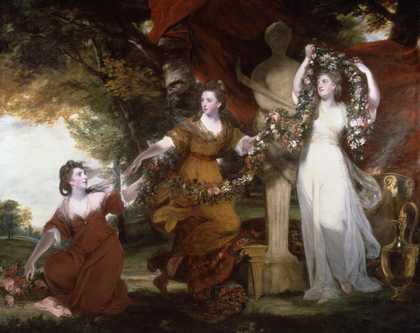
Sir Joshua Reynolds, Three Ladies Adorning a Term of Hymen 1773. Tate.
The Exhibition Age 1760–1815
16 rooms in Historic and Early Modern British Art
The first public exhibitions bring new audiences and new status to British art. This gallery recreates the spectacle of these early displays
The first temporary exhibition of contemporary art opens in London in 1760. Many more soon follow, notably the annual summer exhibitions held from 1769 by the new Royal Academy. For the thousands of visitors attending, these exhibitions can be overwhelming, unruly experiences. Noisy, hot and overcrowded, people come for the spectacle as much as for the art. They are as bursting with paintings as with people. As in this room, the pictures are densely hung from floor to ceiling in a kaleidoscope of styles and subjects.
For artists, this brings new challenges and opportunities. They worry that their work cannot be seen properly in the crowded conditions. To stand out against the competition, they bring ever greater individuality, experimentation and even flamboyance to their work. Art becomes regularly talked about in the newspapers, and reviews from critics can make or break careers.
Exhibitions become fashionable events. Artists are able to directly address more people than ever before, beyond a small number of elite patrons. To engage this wider public, their work often reflects popular interests and current affairs. Exhibitions become places where the nation’s ideas and anxieties are expressed.
There is a new buzz around British art. A sense of national identity is projected through these exhibitions. They help define a ‘British school’, which is celebrated as a sign of the nation’s cultural wealth and progress. Exhibitions contribute to how the country imagines itself on the world stage.

Thomas Stothard, Nymphs Discover the Narcissus exhibited 1793
Thomas Stothard depicts a scene here from the Roman poet Ovid’s mythological narrative, Metamorphoses. The boy Narcissus, obsessed with his own reflection in the water, wastes away and turns into a flower. Here a group of nymphs discover the flower growing on the riverbank. The painting was first exhibited at the Royal Academy in 1793. Stothard’s steadiest form of income was book illustration, but his reputation as a history painter was beginning to grow in the 1790s. It was on this basis that he was elected a full member of the Royal Academy in 1794.
Gallery label, October 2023
1/30
artworks in The Exhibition Age
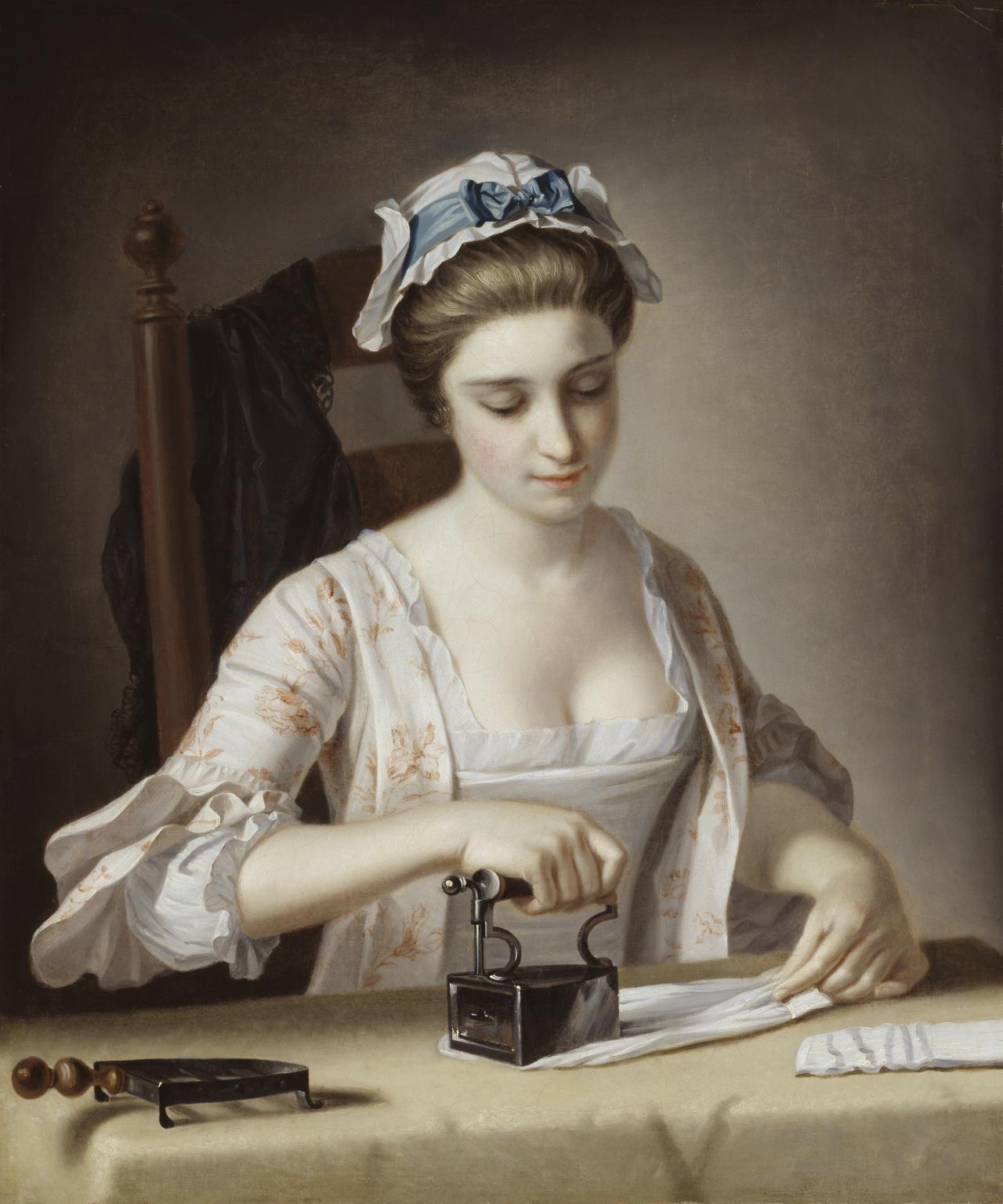
Henry Robert Morland, A Laundry Maid Ironing c.1765–82
This painting of a maid ironing is typical for Morland, who specialised in such ‘fancy pictures’ - subjects drawn from everyday life but with imaginative elements. He repeatedly painted and exhibited idealised pictures of young women in working-class roles, as ballad singers, oyster sellers and laundry maids. Here, the woman is shown passively gazing down, serene as she works, her tools and appearance pristine. There is little indication of her individuality, or of the real hardship of such domestic labour. Instead, she represents a contrived ‘type’, made attractive for contemporary middle and upper-class viewers and saleable for the print market.
Gallery label, June 2022
2/30
artworks in The Exhibition Age
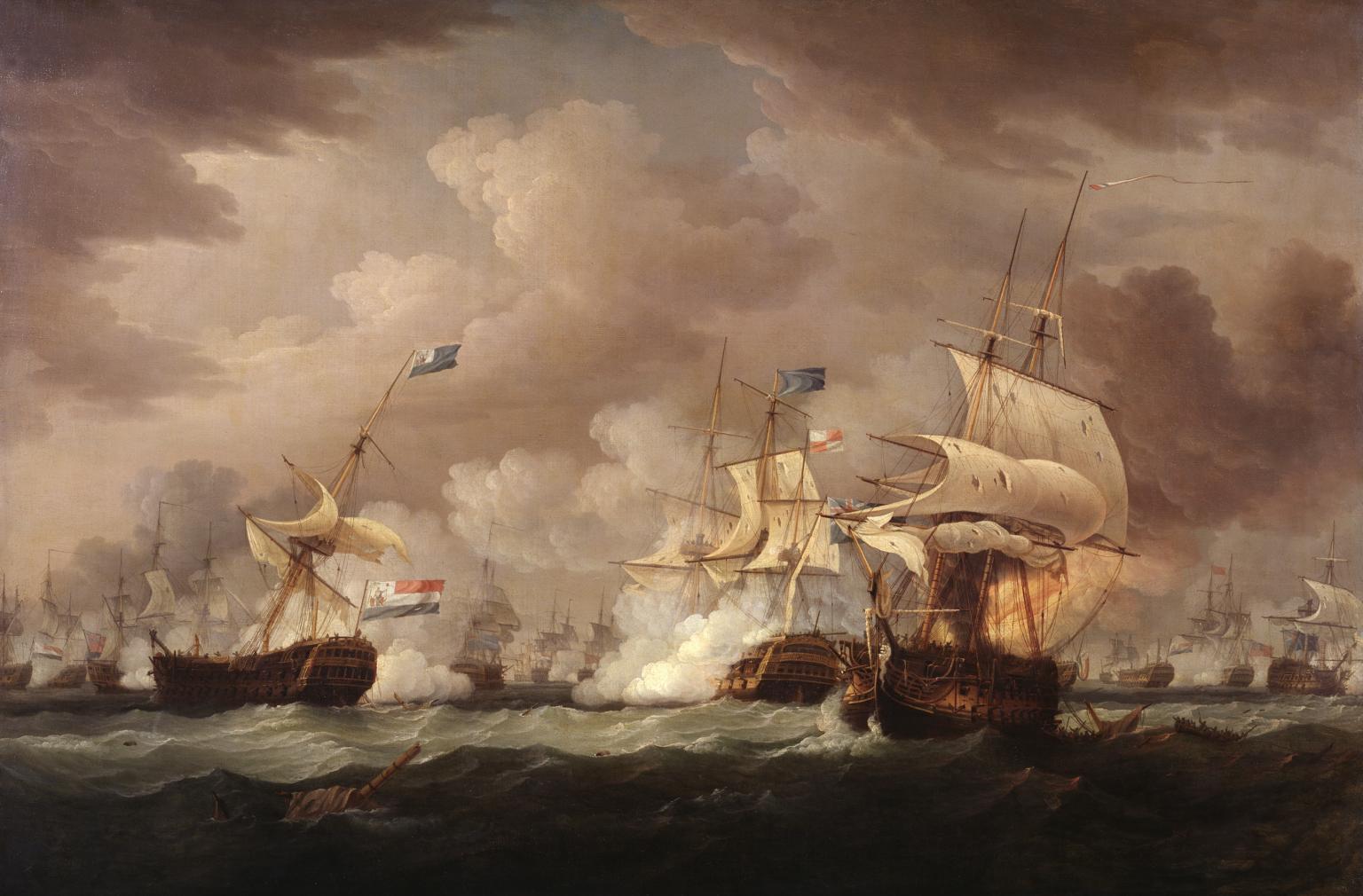
Thomas Whitcombe, The Battle of Camperdown 1798
This painting shows the naval battle that took place on 11 October 1797 near Camperduin, off the coast of North-Holland in the Netherlands. Whitcombe depicts the dramatic moments shortly after the British ship Venerable fired at its Dutch opponent Vrijheid. Just behind Venerable, to the right, is the Dutch ship Alkmaar in flames. The battle resulted in a resounding victory for the British fleet midway through the French Revolutionary Wars (1792–1802). Thomas Whitcombe specialised in maritime pictures, including of naval battles. Images like this, celebrating Britain’s naval power and victories, helped create a sense of national identity.
Gallery label, October 2023
3/30
artworks in The Exhibition Age
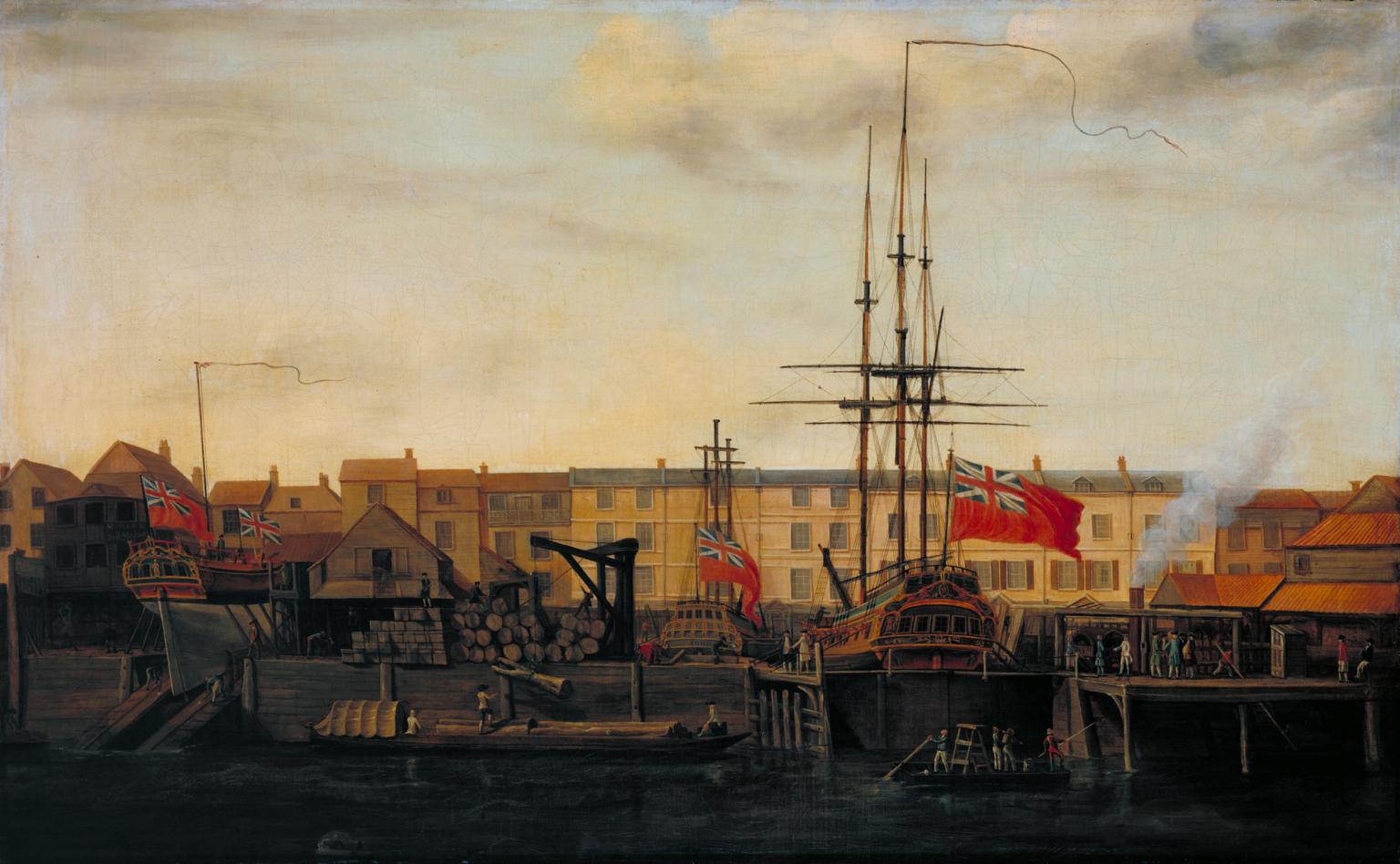
Francis Holman, A Dockyard at Wapping c.1780–4
Little is known about the artist Francis Holman. He was a painter of seascapes, ship's portraits and dockyard scenes, such as this small private dockyard on the Thames at Wapping. It is recorded that at one time Holman lived at Wapping, so he would have been intimate with the area and well able to execute this topographically accurate scene. He depicts with care the busy action of the dock, with ships in dry dock, and men unloading cargo. Even the sailmaker's firm of Morley, which is inscribed on the sign on the building to the extreme left, is known to have existed, directories listing it in Wapping until 1784.
Gallery label, August 2004
4/30
artworks in The Exhibition Age
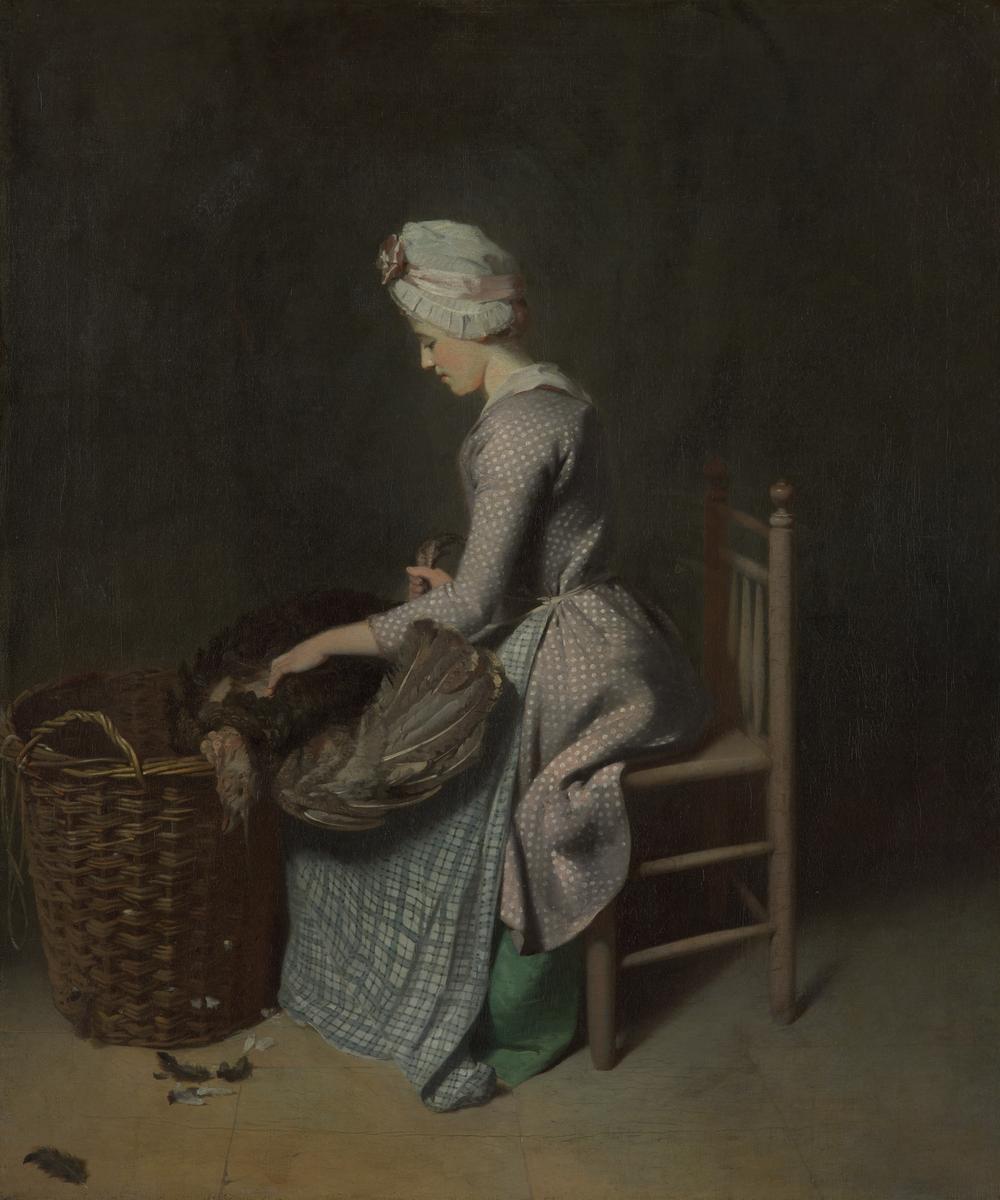
Henry Walton, Plucking the Turkey exhibited 1776
This painting was exhibited in London in 1776, during the early stages of the war with revolutionary America. Walton’s image of a cookmaid plucking a turkey is an example of the kind of lowly subject-matter denigrated by Sir Joshua Reynolds and the new Royal Academy.
But it may also make a coded political reference. The turkey was very closely associated with America: Benjamin Franklin even proposed that it should become the symbol of independent America, instead of the eagle. The painting may, therefore, be a pro-British comment on the anticipated fate of the rebellious colonists.
Gallery label, September 2004
5/30
artworks in The Exhibition Age
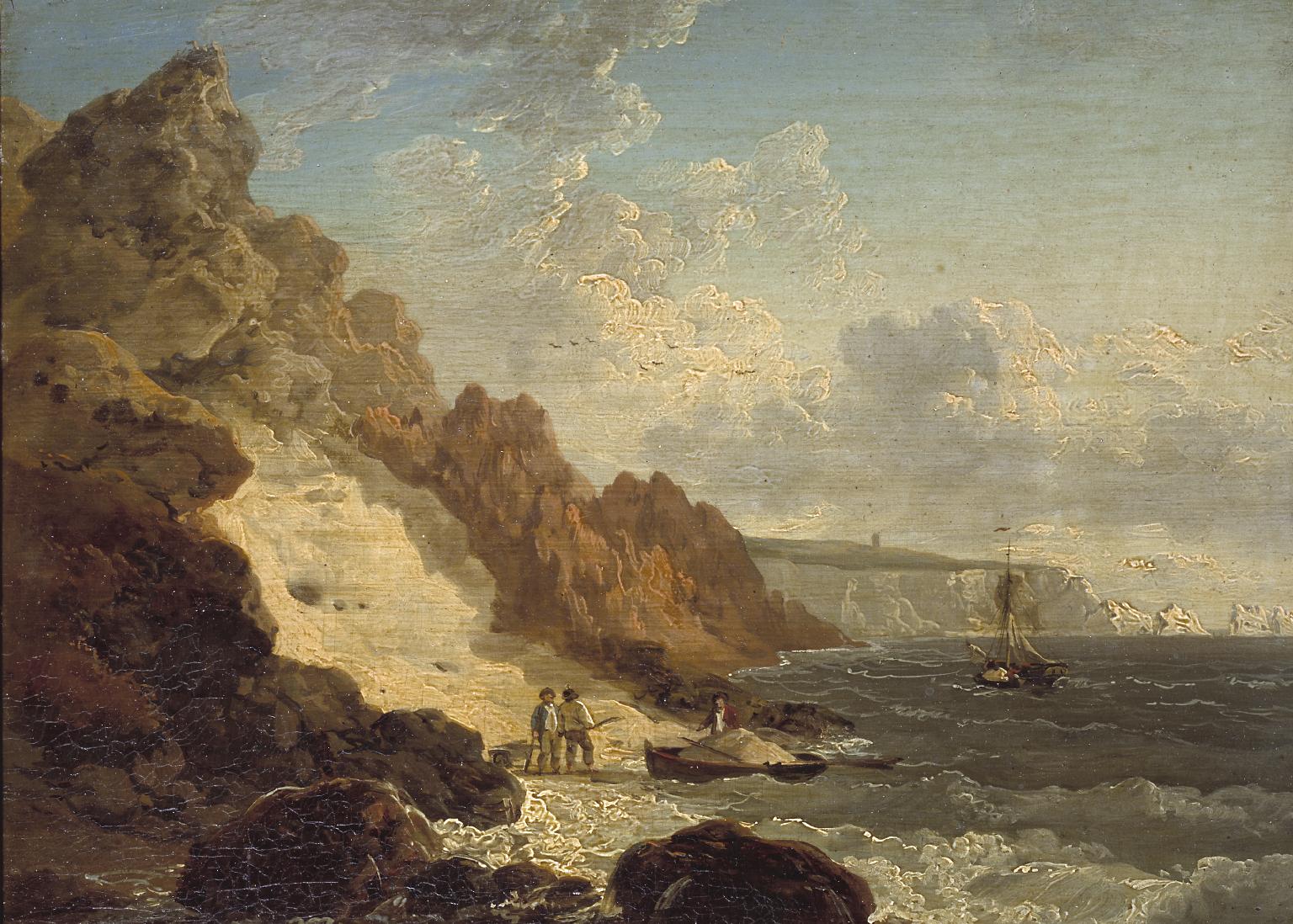
Julius Caesar Ibbetson, Sand Quarry at Alum Bay ?exhibited 1792
Julius Caesar Ibbetson visited the Isle of Wight in 1791, which inspired him to paint many views of the coves and cliffs. This picture shows the local scenery at Alum Bay, with a group of men quarrying sand in the foreground. The famous Needles – a row of chalk stacks in the sea – are visible in the distance. This is probably one of the several coastal scenes of the Isle of Wight that Ibbetson exhibited at the Royal Academy between 1792 and 1796. Throughout his career, Ibbetson travelled widely, including to China and the island of Java in Indonesia (then a Dutch colony). Many of his landscape paintings were inspired by the places he visited.
Gallery label, October 2023
6/30
artworks in The Exhibition Age
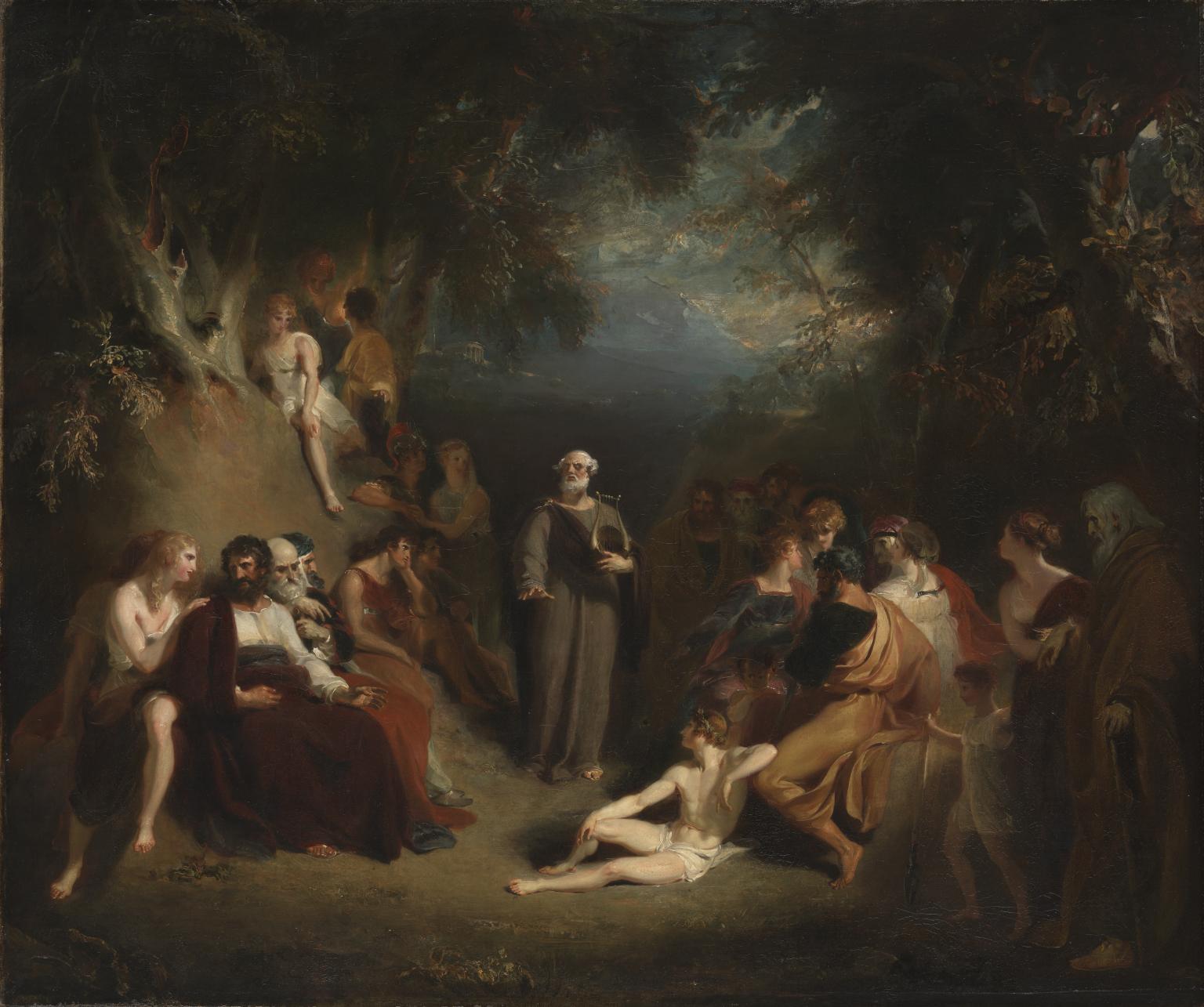
Sir Thomas Lawrence, Homer Reciting his Poems 1790
For most of his career, Lawrence featured in the Royal Academy exhibitions as a portrait painter. He became President of the Academy and, like his predecessor Joshua Reynolds, aspired to be a history painter. This early work was exhibited in 1791. It was painted for the connoisseur, Richard Payne Knight, and its subject and style were calculated to suit his classical taste. In a woodland glade, the Greek poet Homer is shown reciting his Iliad to an admiring audience. The nude youth in the foreground was drawn from a famous pugilist (professional boxer) named Jackson.
Gallery label, February 2016
7/30
artworks in The Exhibition Age
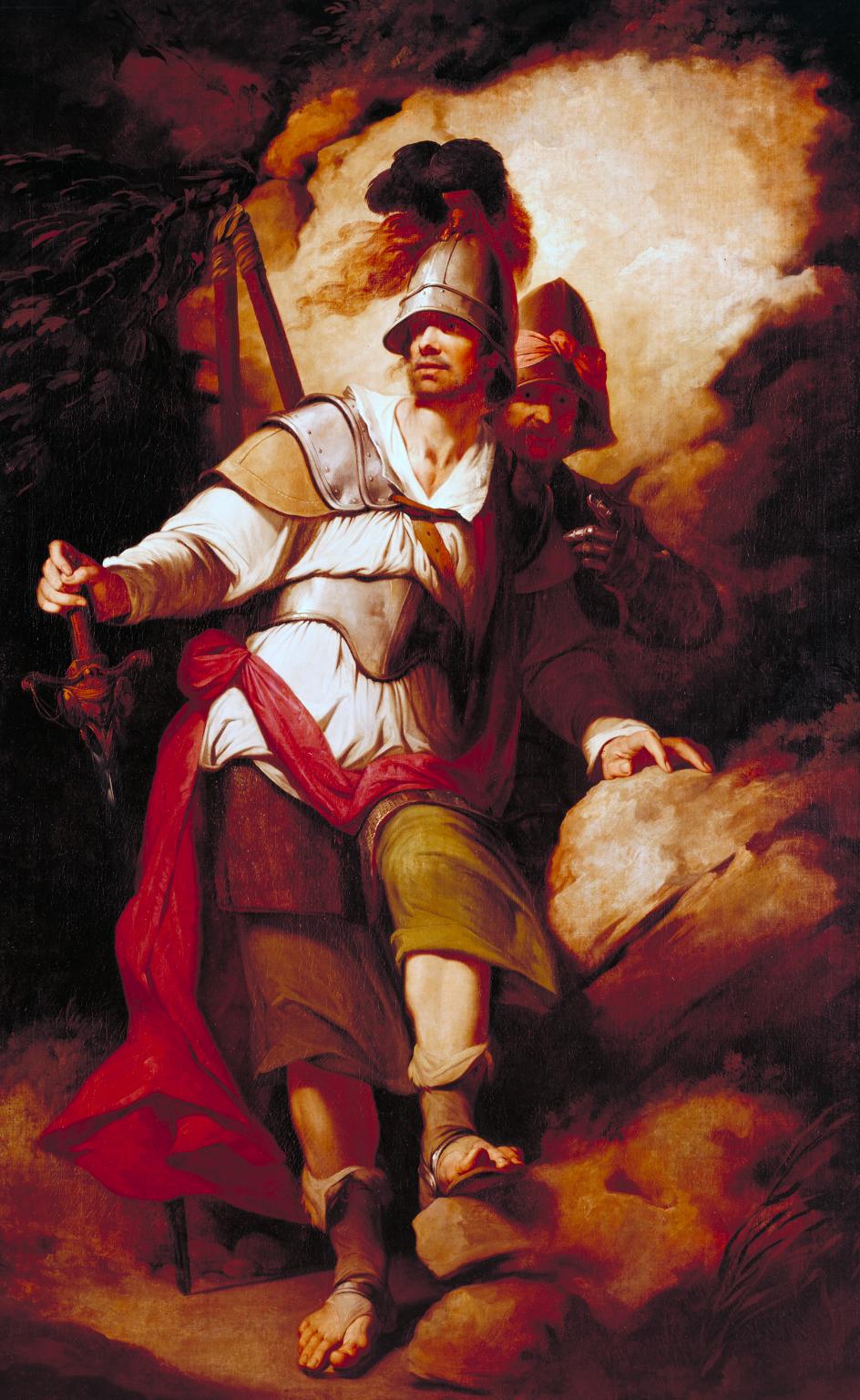
John Hamilton Mortimer, Sir Arthegal, the Knight of Justice, with Talus, the Iron Man (from Spenser’s ‘Faerie Queene’) exhibited 1778
This painting refers to the courtly fantasy of British origins prevalent in the Elizabethan age and the seventeenth century. It illustrates Edmund Spenser’s The Fairie Queene 1590/6, a poem that claims Elizabeth I as heir to King Arthur’s British kingdom.
Arthegal was one of the Queene’s knights, trained by the immortal Astraea to be the champion of True Justice. She gave him the invincible sword, Chrysaor, which he holds here. Behind him is Talus, his squire. Talus was a man ‘made of iron mould, immoveable, resistlesse’. He carries an iron flail with which he threshes out falsehood.
Gallery label, September 2004
8/30
artworks in The Exhibition Age
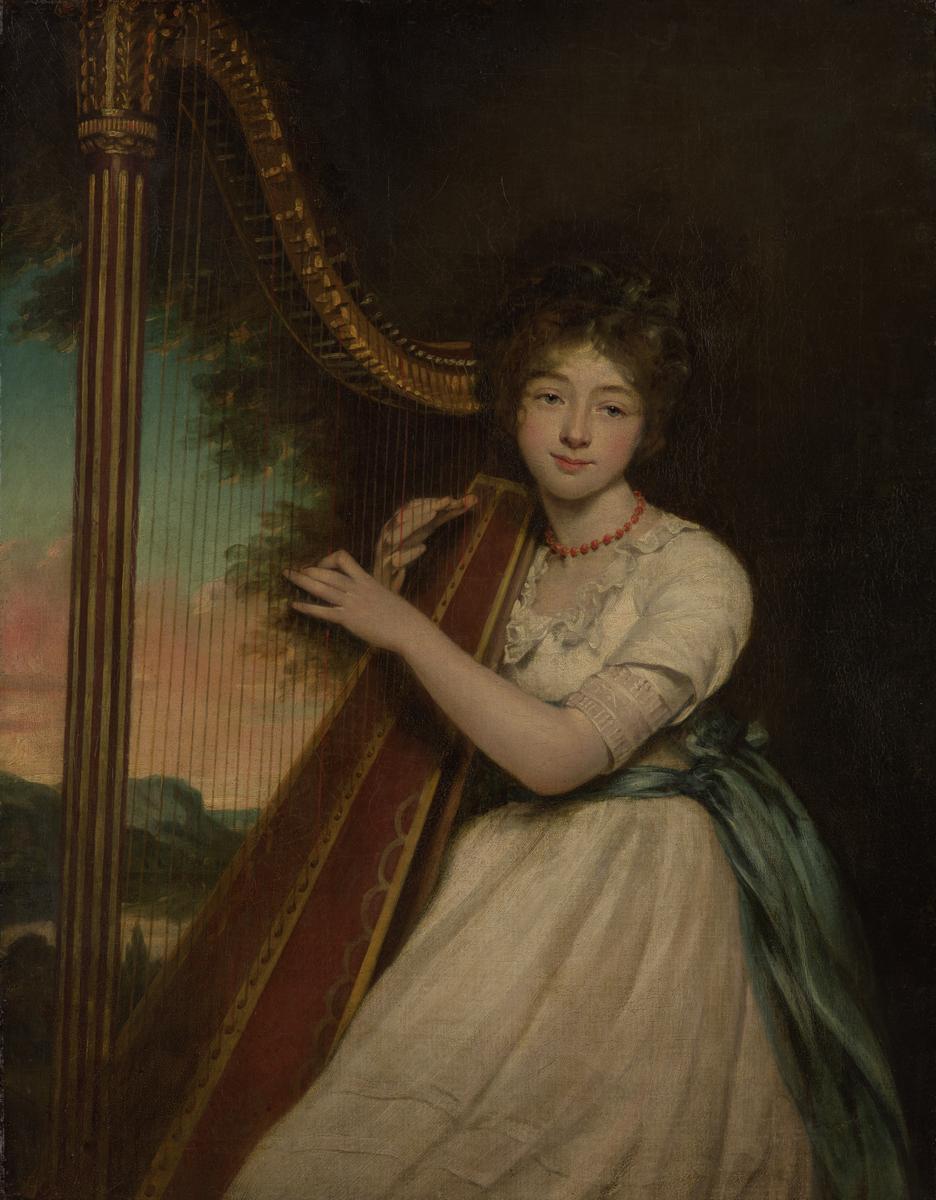
James Northcote, A Young Lady Playing the Harp ?exhibited 1814
A Young Lady Playing the Harp ?exhibited 1814 is an oil painting by the English artist and author James Northcote. It depicts a young harpist wearing a white dress tied with a long green sash, with a string of red beads around her neck. The harpist gazes forward, both hands raised to pluck the strings. She is seated against a rural backdrop dominated by a large, dark tree on the right, which frames her compositionally. The backdrop on the left, seen through the strings of the harp, features a twilit sky over hills and a lake.
9/30
artworks in The Exhibition Age
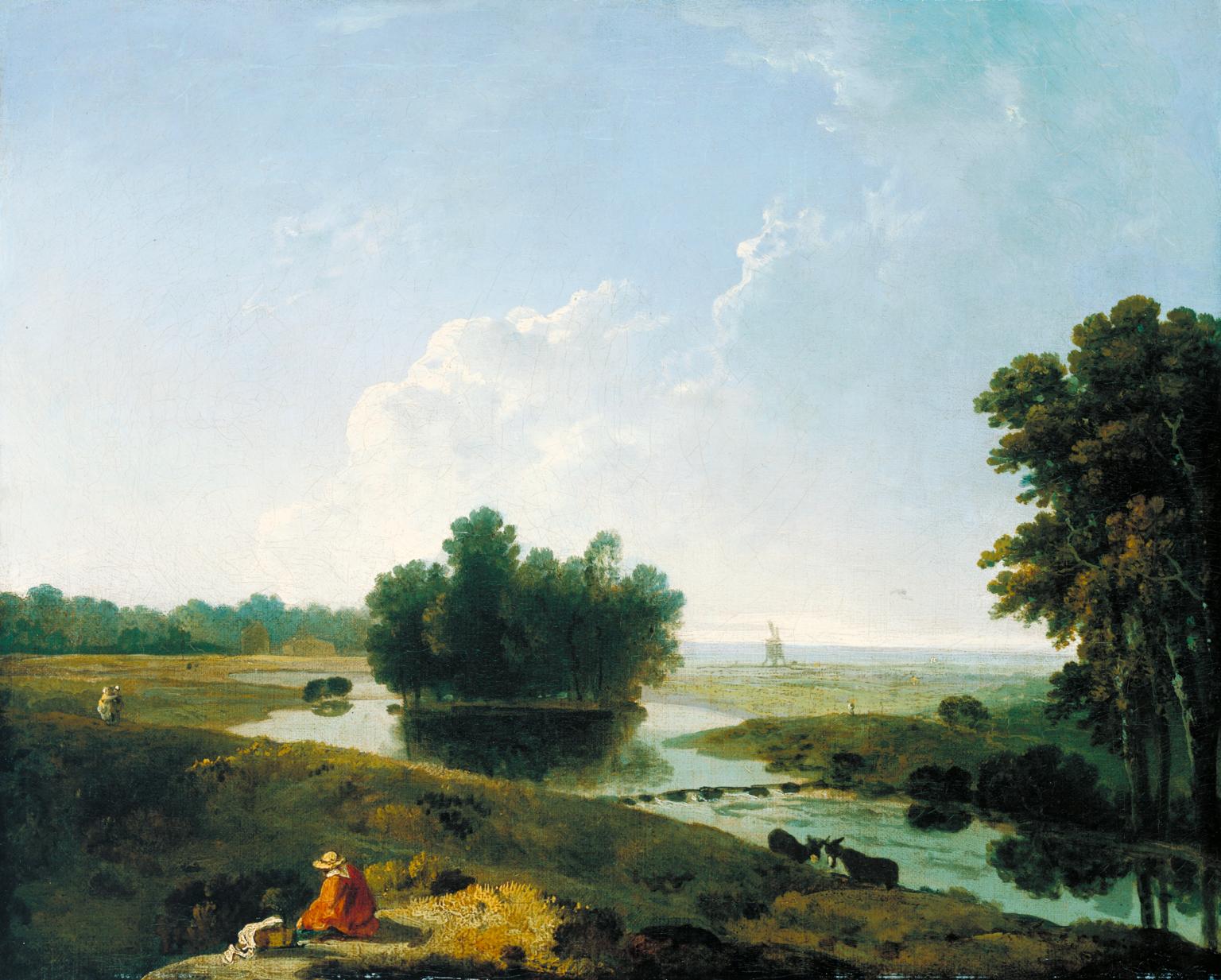
Richard Wilson, On Hounslow Heath ?exhibited 1770
The view shows the watermeadows beside the River Crane. This area of Hounslow Heath was not known for its beauty or cultural significance. Instead, the attraction of this picture lies in the beauty of the sky and the reflections in the water. In this it is an example of a new type of landscape view, designed to bring a vision of a rural idyll into the city dweller's home. The picture was commissioned by Tom Davies, who was a Bloomsbury bookseller, and one of a growing number of middle-class urban patrons of English landscape subjects.
Gallery label, September 2004
10/30
artworks in The Exhibition Age
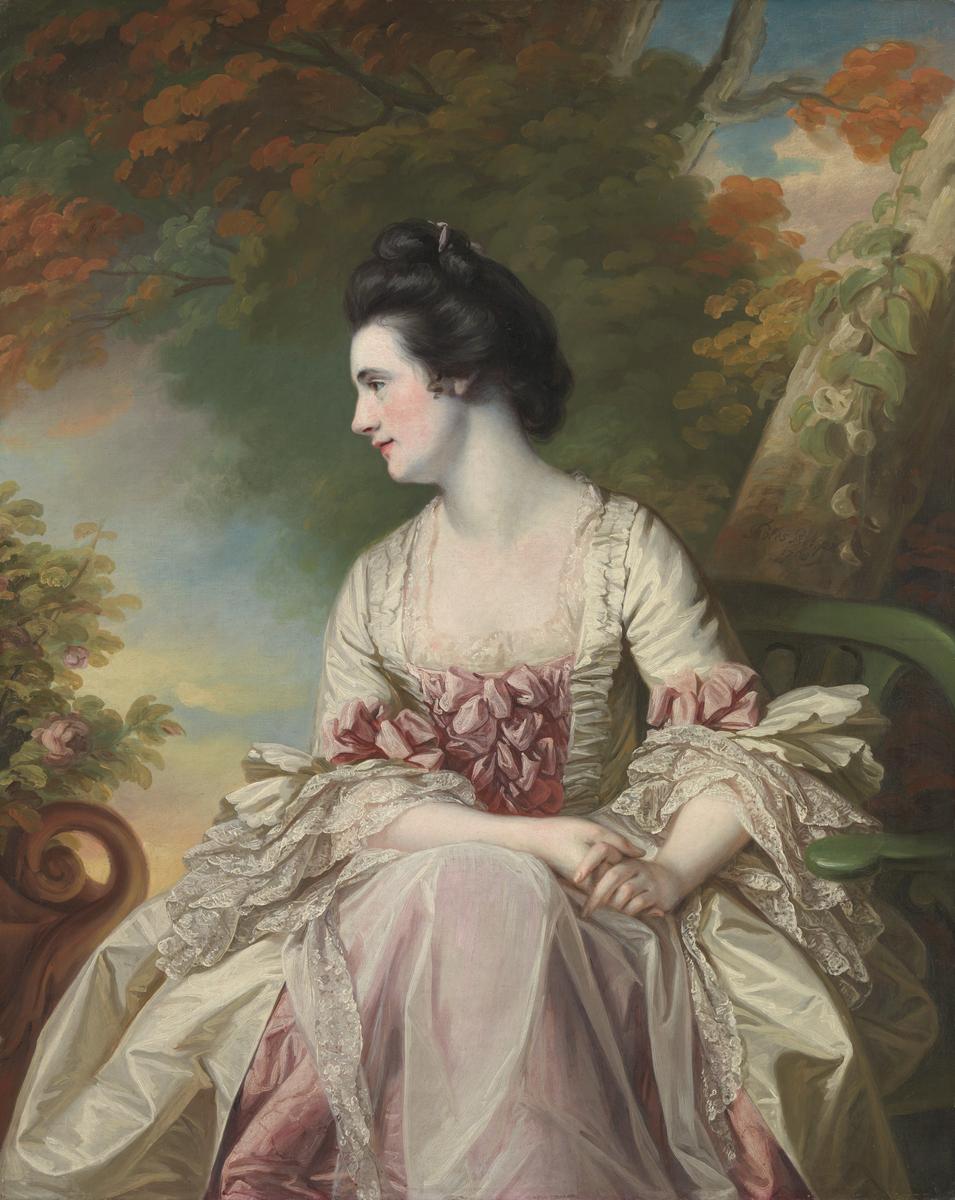
Francis Cotes, Portrait of a Lady 1768
This elegant and ornamental portrait
is a fine example of Cotes's style, which emphasises fashion rather than character. The sitter, whose identity is uncertain, sits on a garden bench in an artificial yet striking pose. Her gown and its lace are arranged decoratively about her, the pink and white colouring echoed by the foxgloves behind her, and the roses on the left. The portrait was painted in 1768, the same year as the foundation of the Royal Academy. Cotes was one of its founder members, which his prominent signature on the tree trunk, 'F Cotes RA px', proudly announces.
Gallery label, February 2010
11/30
artworks in The Exhibition Age
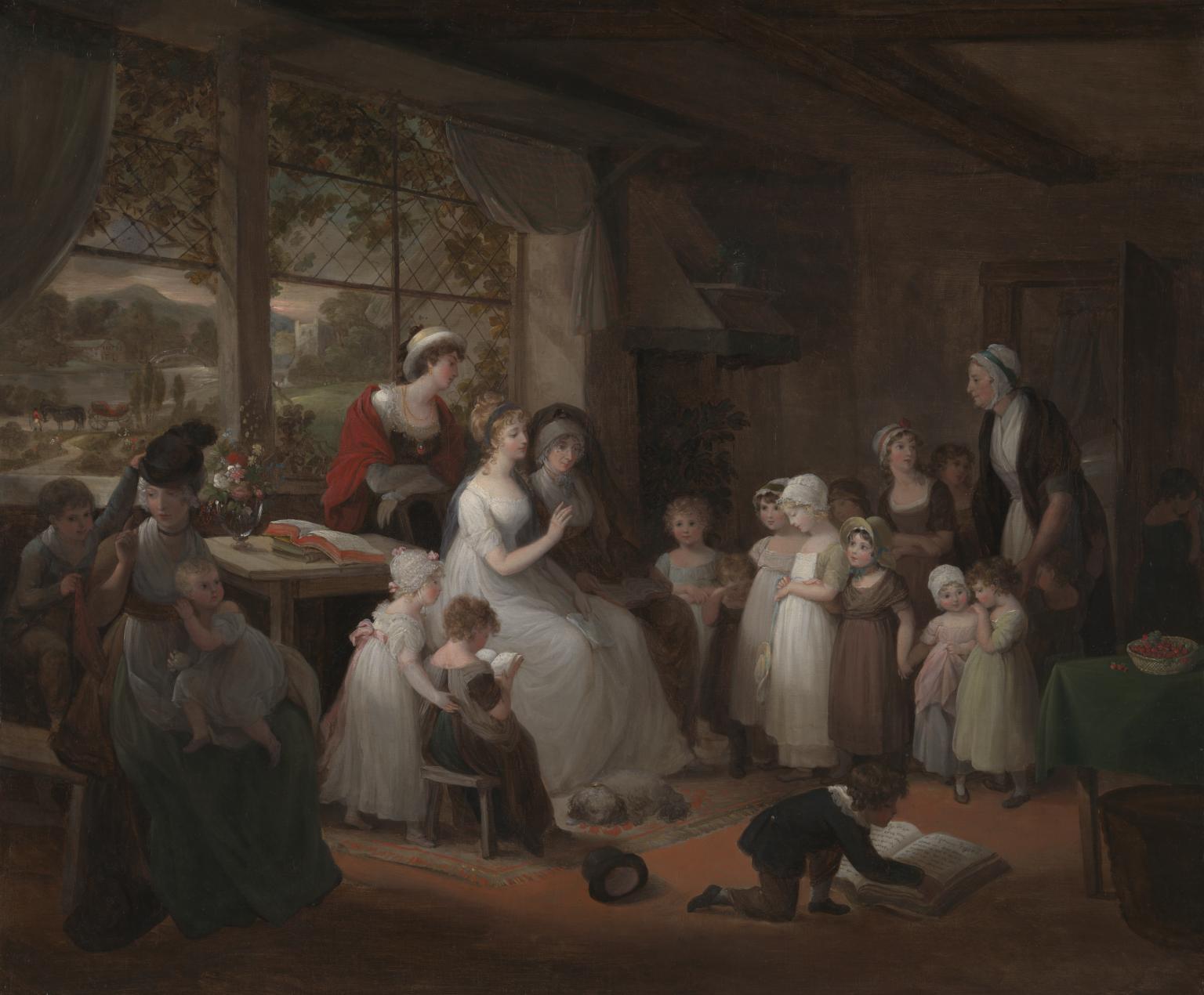
Maria Spilsbury, The Schoolmistress c.1803
A young woman in white is shown teaching the children gathered around her. One boy sits absorbed in reading A Pilgrim’s Progress, by John Bunyan. The Christian message of this book is reinforced by the church seen in the distance. Maria Spilsbury often portrayed women in such nurturing roles, reflecting the importance of women educators at this time. Women were especially active in the growing Sunday School movement, which aimed to educate working-class children on Sundays, their one day off. Spilsbury also painted a larger version of this picture (with more overt Christian symbolism) and probably exhibited one of these at the Royal Academy in 1804. At that time, her work was reputedly so popular that carriages would queue outside her London studio.
Gallery label, October 2023
12/30
artworks in The Exhibition Age
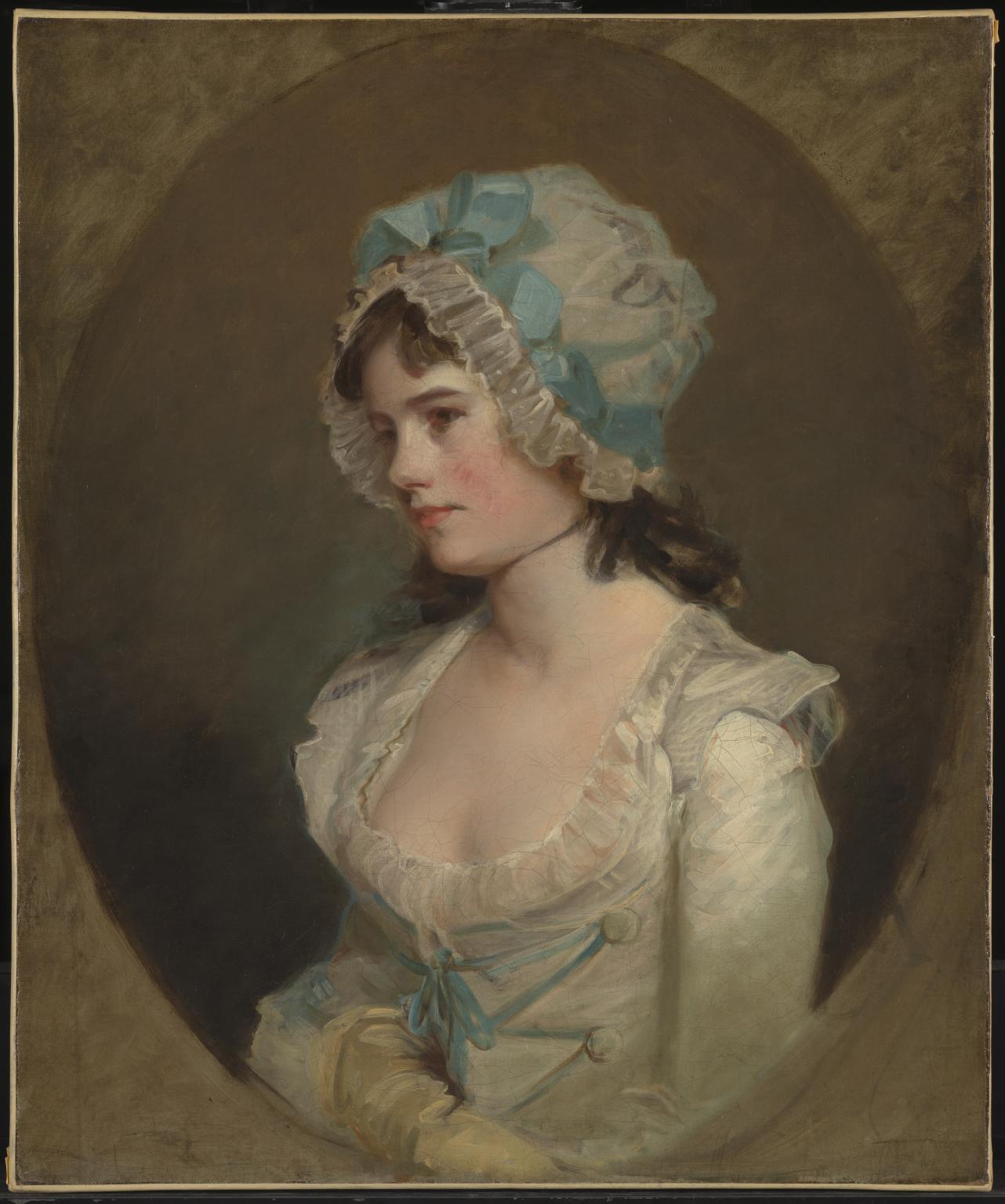
John Hoppner, Mrs Williams c.1790
Little is known about the woman in this painting. She is thought to have been the wife of a Captain Williams. John Hoppner portrays her in her youth, possibly before her marriage. Hoppner was a skilled colourist, demonstrated in Mrs William’s rosy cheeks and the blue trimmings of her bonnet and blouse. He first exhibited at the Royal Academy in 1780. While he was initially interested in landscape painting, Hoppner soon turned to portraiture which provided a steadier source of income. He achieved considerable success, receiving commissions from numerous aristocrats and members of the royal family.
Gallery label, October 2023
13/30
artworks in The Exhibition Age
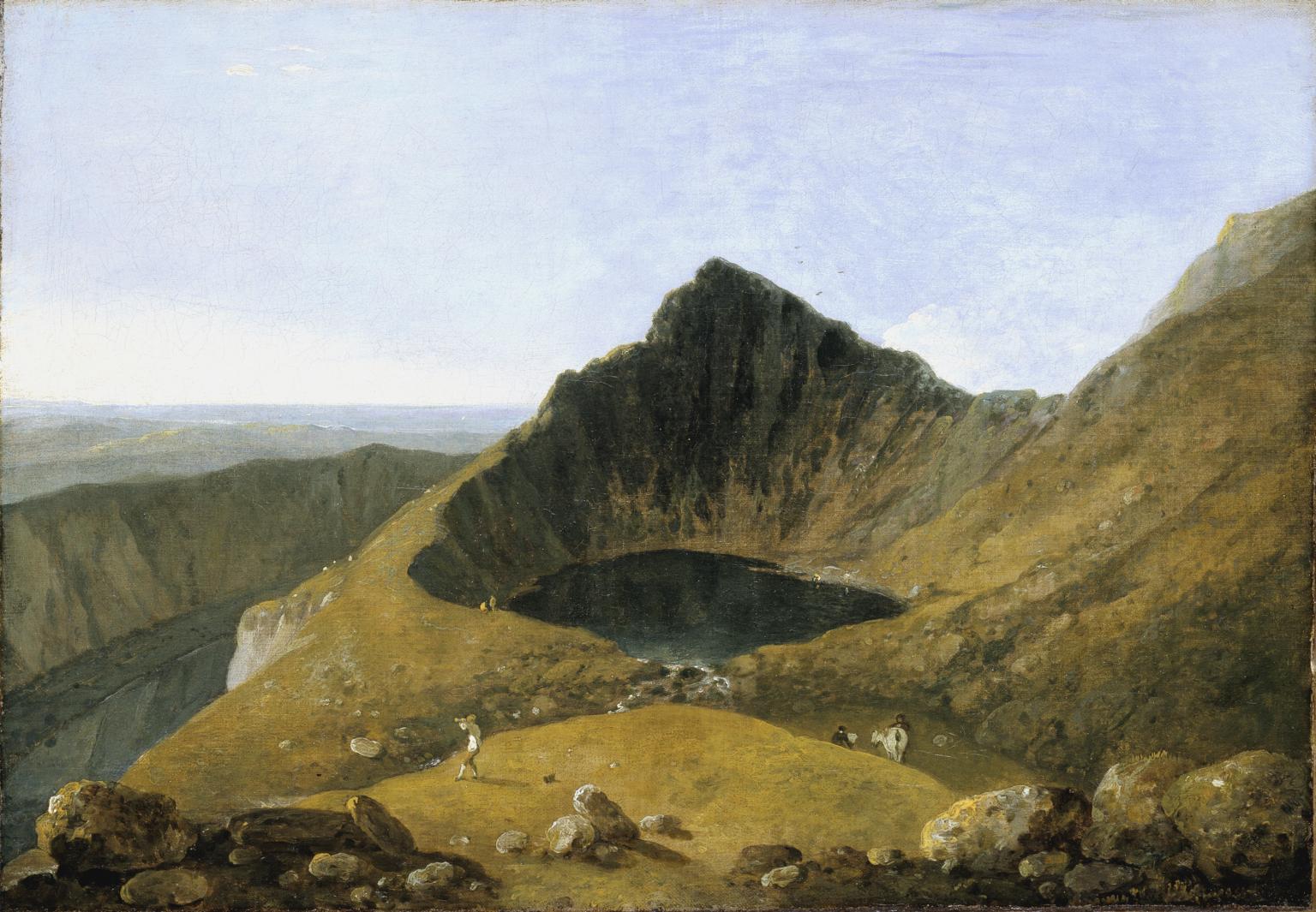
Richard Wilson, Llyn-y-Cau, Cader Idris ?exhibited 1774
Richard Wilson paints Llyn Cau, a lake near the summit of Cadair Idris in North Wales. He heightened the precipice and included imagined landscape features to create a balanced, more ordered composition. The tiny people underscore the monumental scale of the scenery. Wilson suggests we are looking at an untouched paradise, ideal for contemplating nature. The figure with a telescope may reflect the fashionable enthusiasm for such remote scenery. The Welsh countryside particularly appealed to Wilson’s contemporaries because of the new taste for sublime awe-inspiring landscapes and the growing interest in Welsh history and culture.
Gallery label, February 2024
14/30
artworks in The Exhibition Age

Gilbert Stuart, Portrait of a Man (Self-portrait?) c.1782–9
The American artist Gilbert Stuart probably painted this work in the 1780s, either in London or Dublin (where he moved in 1787). Stuart emerged as an independent artist in these years, becoming a rising star in the art world. This painting seems to reflect his growing confidence. It is painted with bold, emphatic brushstrokes and Stuart uses characteristically distinct, vibrant colours. The sitter himself, looks directly out at the viewer, his arms crossed. We don’t know the young man’s identity, although in the past it was thought to be a self-portrait.
Gallery label, February 2024
15/30
artworks in The Exhibition Age
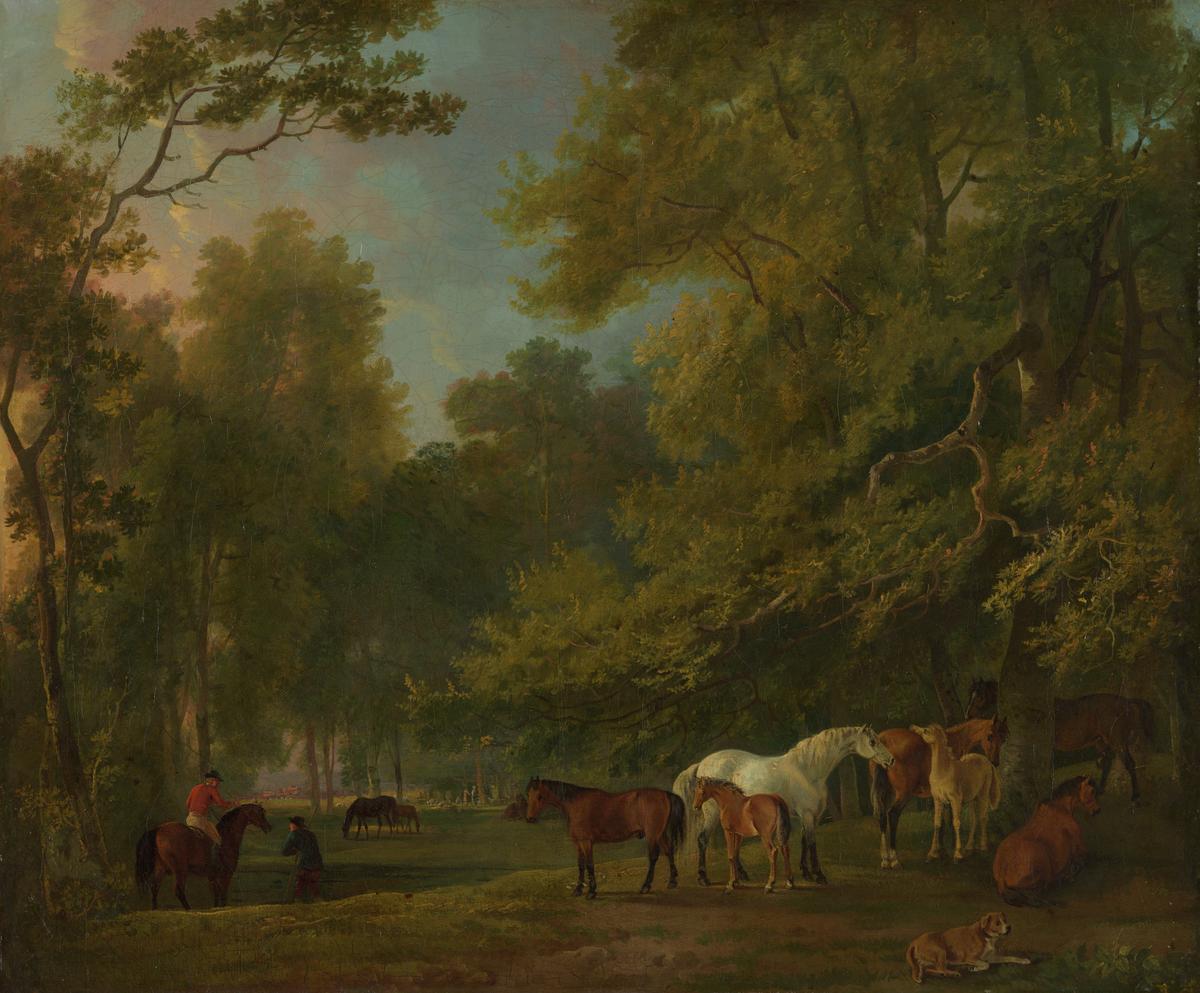
Sawrey Gilpin, George Barret Senior, Broodmares and Colts in a Landscape ?exhibited 1783
This painting was a collaboration between the artists Sawrey Gilpin and George Barret, who painted the horses and landscape respectively. Gilpin was a skilled painter of horses but lacked confidence in painting landscapes. He often invited other artists to add landscape backgrounds to his pictures. This was not an unusual practice for artists as it made the most of their specialisms. Barret and Gilpin collaborated on several occasions. This raised the ambition and quality of Gilpin’s artworks, increasing their status at exhibitions or sales. This painting is thought to have been exhibited at the Society of Artists in 1783.
Gallery label, October 2023
16/30
artworks in The Exhibition Age
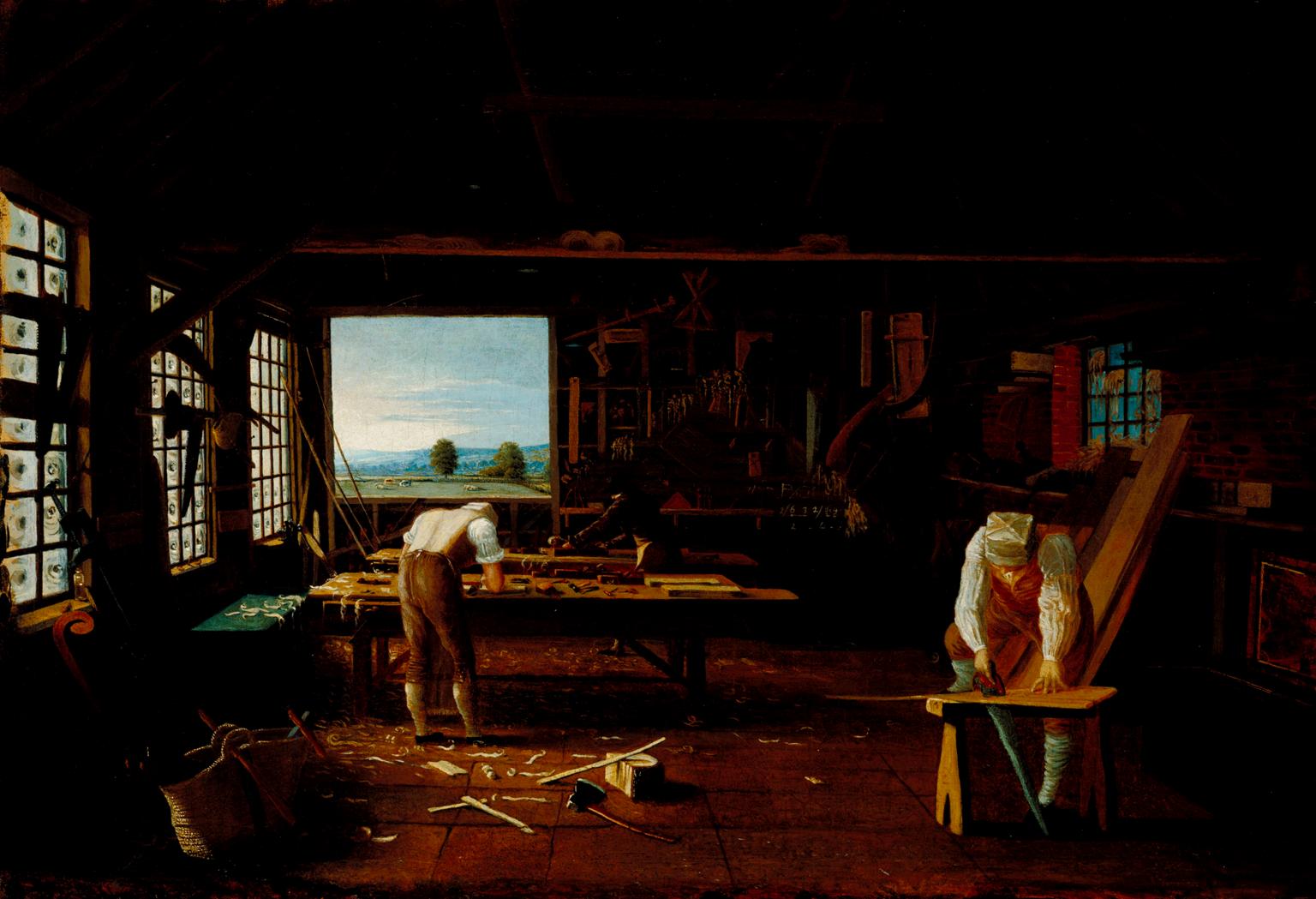
John Hill, Interior of the Carpenter’s Shop at Forty Hill, Enfield ?exhibited 1813
John Hill shows the interior of a small joinery shop that likely belonged to him and his father Thomas. Various tools and stages of production are visible: an axe and saw for cutting the wood in the foreground, and a planer for shaping it in the background. The unglazed window in the far corner of the workshop is large enough for big pieces of wood to pass through. It also provides ventilation and light for the ‘master’ carpenter. He is distinguished from his assistants by his moleskin hat and dark jacket. John likely included himself in the picture, possibly as this master carpenter (although this figure might also be his father). John later described himself as an ‘entirely self-taught' painter. He exhibited this painting at the Royal Academy in 1813. Such representations of craftsmen at work are rare in British art of this period.
Gallery label, October 2023
17/30
artworks in The Exhibition Age
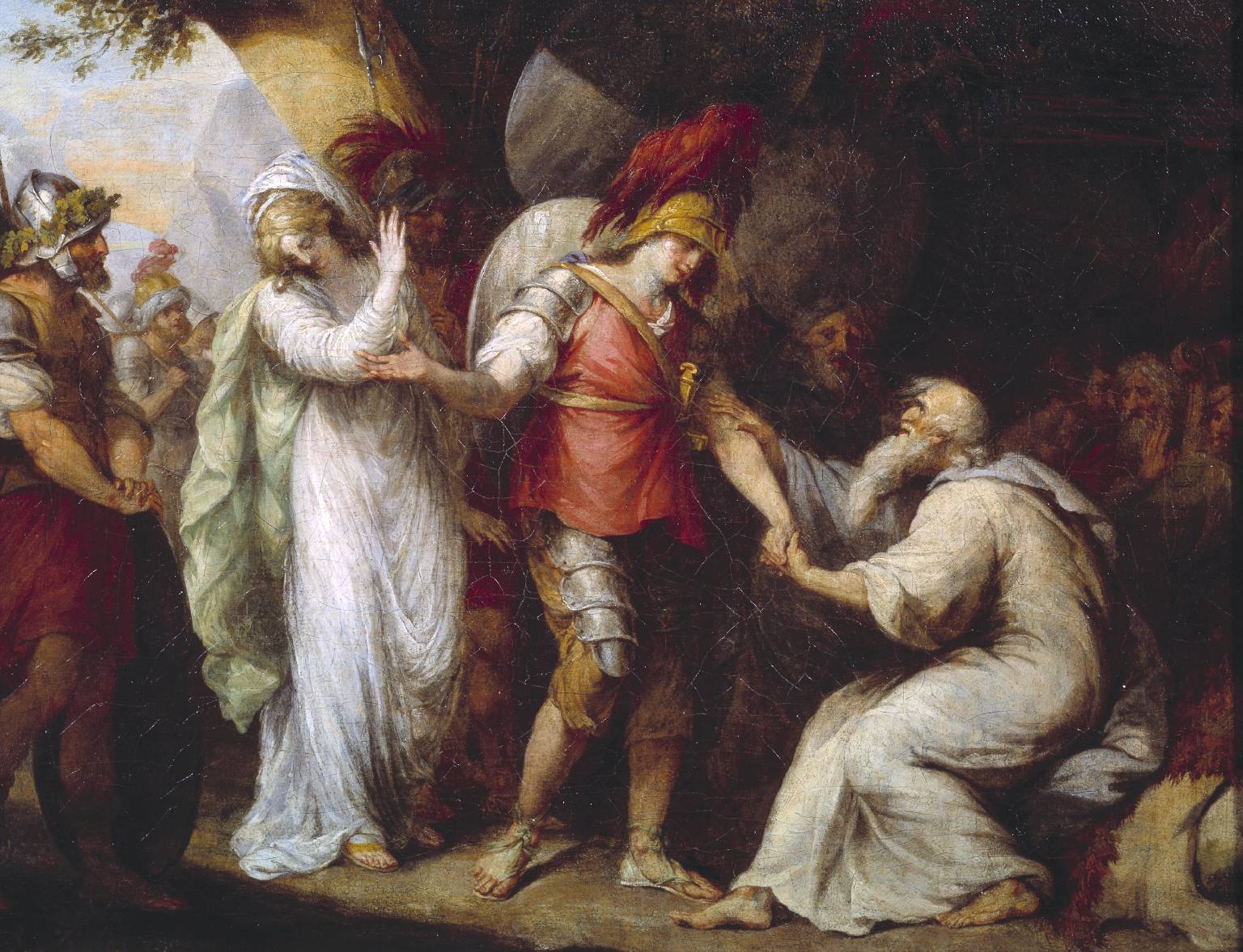
Charles Reuben Ryley, Oscar Bringing Back Annir’s Daughter 1785
Scotland’s legendary past, as told by the ancient Gaelic bard, Ossian, inspired this painting. It shows the famed warrior Oscar (in red), returning triumphant from battle to Annir, the elderly King of Inis-Thona. Oscar's victory reunites the king with his daughter. Ossian’s epic poem was published in 1765 and inspired many artists and writers. Nearly 60 Ossian subjects were exhibited in London between 1771-1830, including five pictures by Charles Reuben Ryley. However, the authenticity of the poem was soon questioned. The publisher, James Macpherson, had, in fact, invented the saga by blending Gaelic mythology with other sources and his own writing.
Gallery label, February 2024
18/30
artworks in The Exhibition Age

Francesco Zuccarelli, A Landscape with the Story of Cadmus Killing the Dragon exhibited 1765
This painting illustrates the story of Cadmus, founder of the ancient city of Thebes, as told in Ovid’s Metamorphoses. Cadmus is slaying the dragon that has killed his companions. They have died trying to collect spring water from the dragon’s cave, not knowing that it is sacred to the god Mars. Cadmus is protected by a lion-skin and armed with a javelin. The Italian painter Zuccarelli left Venice for London in 1752, his mythological landscapes popular with British patrons. In 1768 he was commissioned to produce works for George III, and was a founding member of The Royal Academy.
Gallery label, February 2016
19/30
artworks in The Exhibition Age
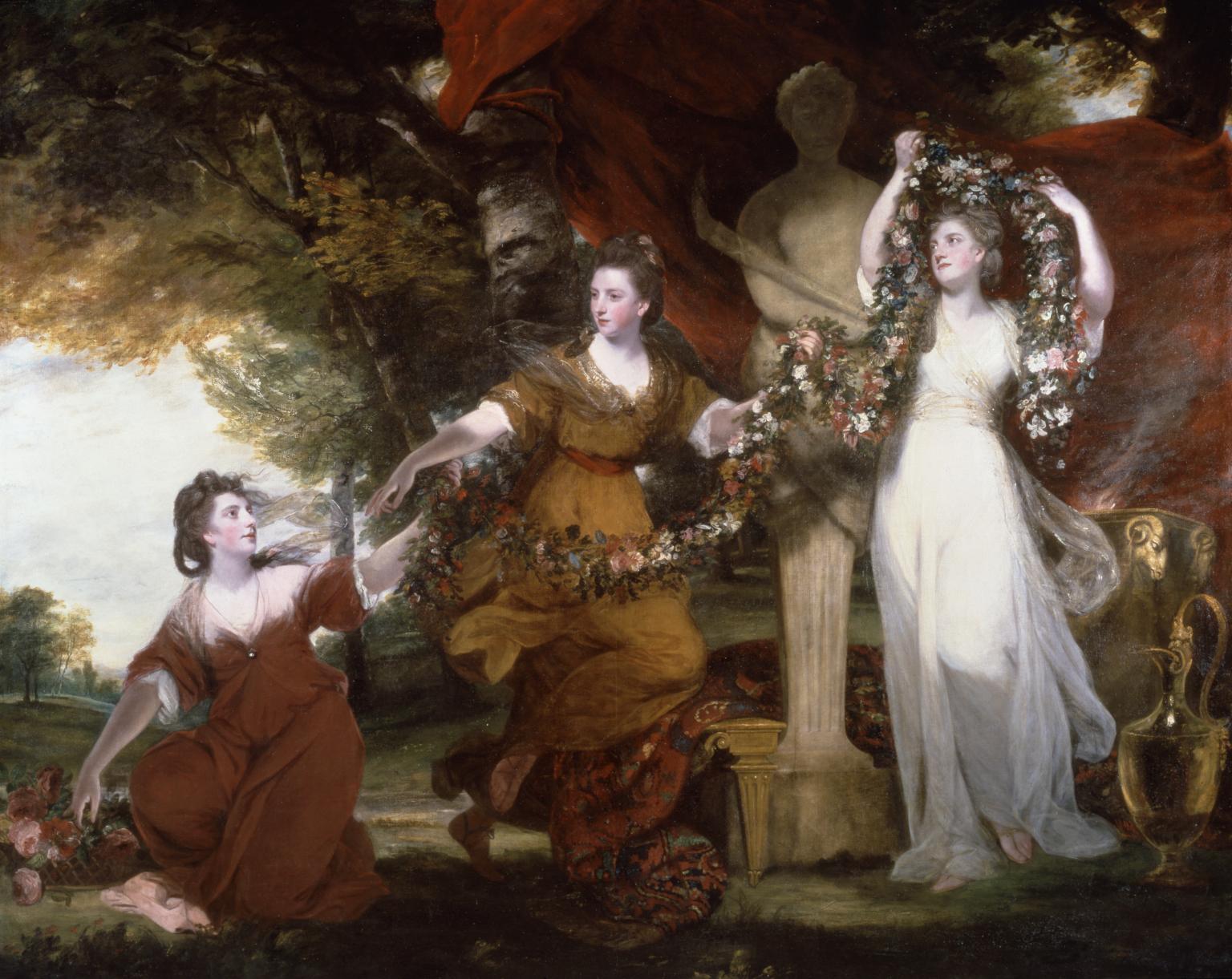
Sir Joshua Reynolds, Three Ladies Adorning a Term of Hymen 1773
Joshua Reynolds paints the aristocratic Montgomery sisters, Barbara, Elizabeth and Anne, decorating a classical sculpture with flowers. Their poses associate them with the mythological Graces, personifying charm, grace and beauty. This emphasises the sisters’ beauty and elegance and may also playfully allude to their fame as ‘The Irish Graces’. By including the statue of Hymen, the Greek god of marriage and fertility, Reynolds also celebrates their desirability for marriage. Reynolds exhibited this painting in 1774. It exemplifies his ‘grand style’ of portraiture, which drew inspiration from classical and Renaissance art, and favoured idealised elements rather than current or specific fashions. The painting prompted one art critic to praise Reynolds’ ‘great Richness of Imagination’.
Gallery label, February 2024
20/30
artworks in The Exhibition Age
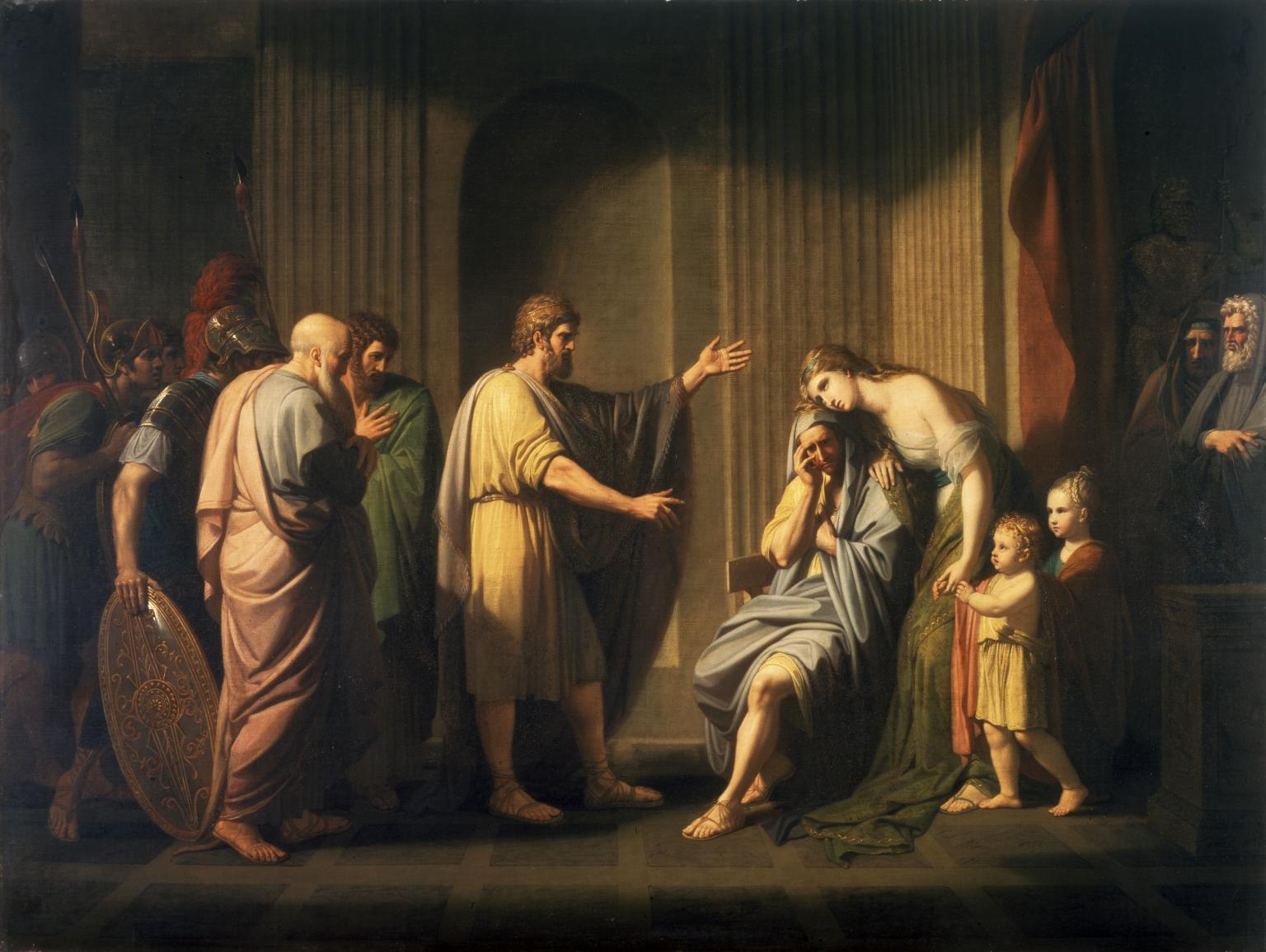
Benjamin West, Cleombrotus Ordered into Banishment by Leonidas II, King of Sparta 1768
Benjamin West showed this painting at the second exhibition of the newly formed Royal Academy. After several years in Italy, West had established himself in London as the leading painter of subjects from classical history. His example, and the Academy’s teaching, encouraged numerous young British artists to study in Italy.
His subject is an incident from ancient Greek history. Leonidas, king of Sparta, was usurped by his son-in-law, Cleombrutus. When Leonidas returns looking for revenge, his daughter pleads for her husband’s life. Leonidas is moved by her tears, and commutes Cleombrutus’s death sentence to banishment.
Gallery label, September 2004
21/30
artworks in The Exhibition Age
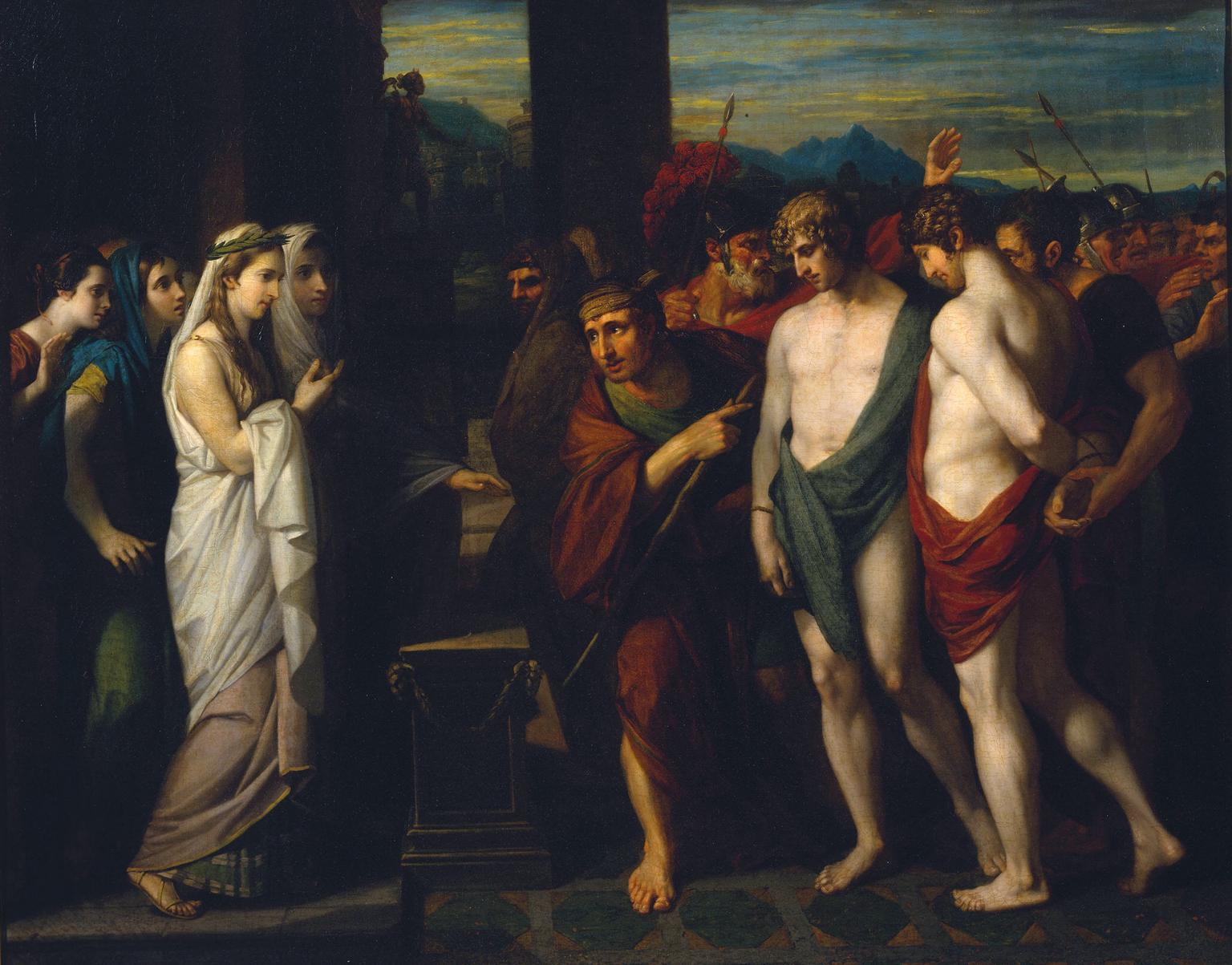
Benjamin West, Pylades and Orestes Brought as Victims before Iphigenia 1766
This painting’s story is based on a play by the classical author Euripides. The two semi-naked men have been arrested for trying to steal a gold statue of the goddess Diana from the temple. They have been brought before Iphigenia, a priestess of Diana, to be sacrificed on the altar. But here Iphigenia recognises the man in the red drapery as her long-lost brother, Orestes. The composition of this picture was heavily influenced by the artist’s studies in Italy. He particularly admired the sculptural friezes on classical tombs and the Renaissance frescoes of Raphael.
Gallery label, February 2016
22/30
artworks in The Exhibition Age
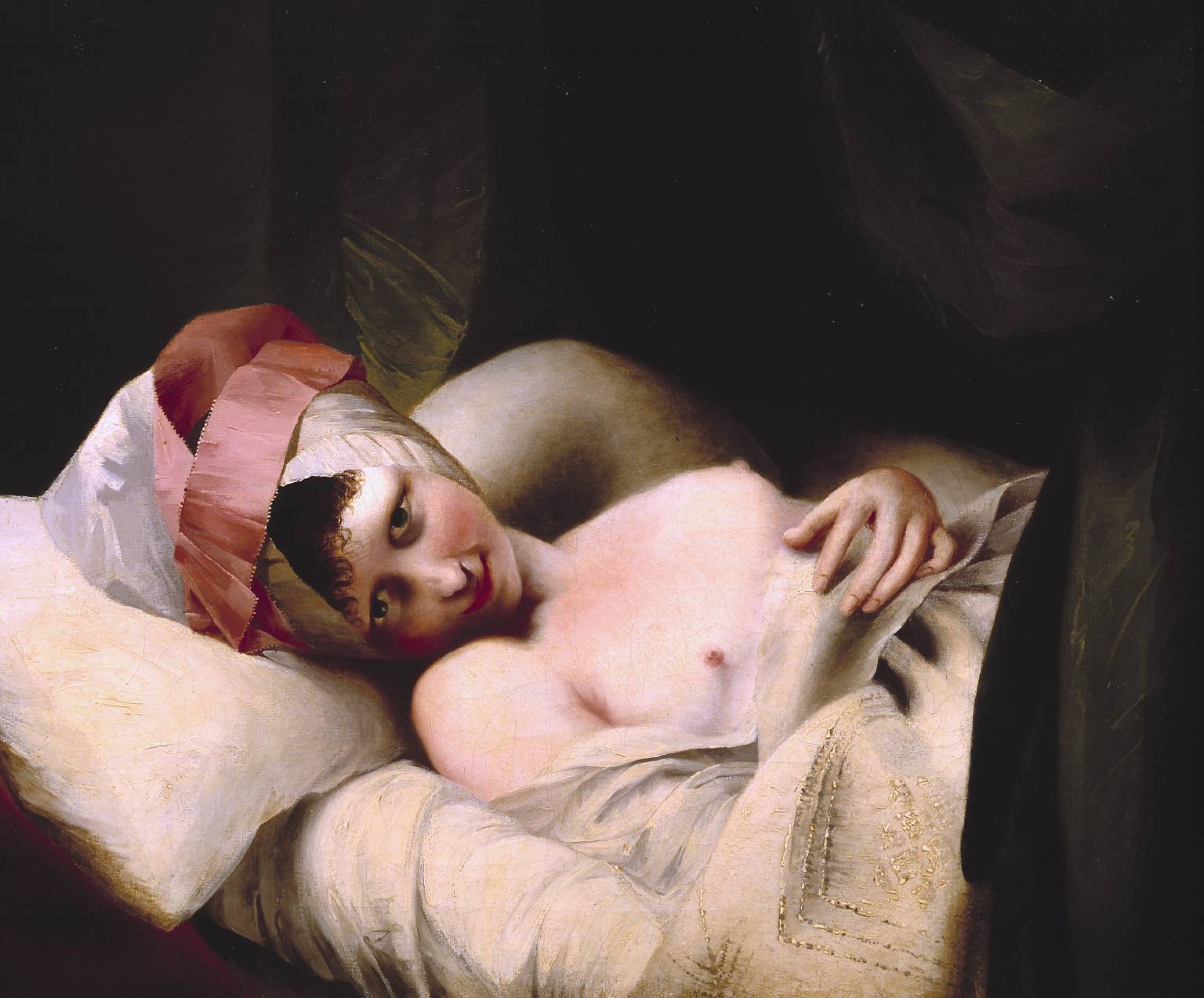
Rev. Matthew William Peters, Lydia c.1777
The explicit eroticism of this picture is unusual in 18th century British art. The semi-naked woman (identified as ‘Lydia’ in a print) gazes provocatively out at the viewer, one hand suggestively hidden. This subject proved popular, and Matthew William Peters painted several versions of it. He exhibited one of these at the Royal Academy in 1777, where it was met with as much amusement as outrage. One critic remarked, it ‘is a good picture, and makes every gentleman stand for some time’. After Peters was ordained as a priest, he reputedly expressed deep regret for painting such erotic subjects. Nonetheless, he was nicknamed the ‘reverend painter of Venuses’, jokingly associating his pictures of desirable women with the goddess of love and beauty.
Gallery label, October 2023
23/30
artworks in The Exhibition Age
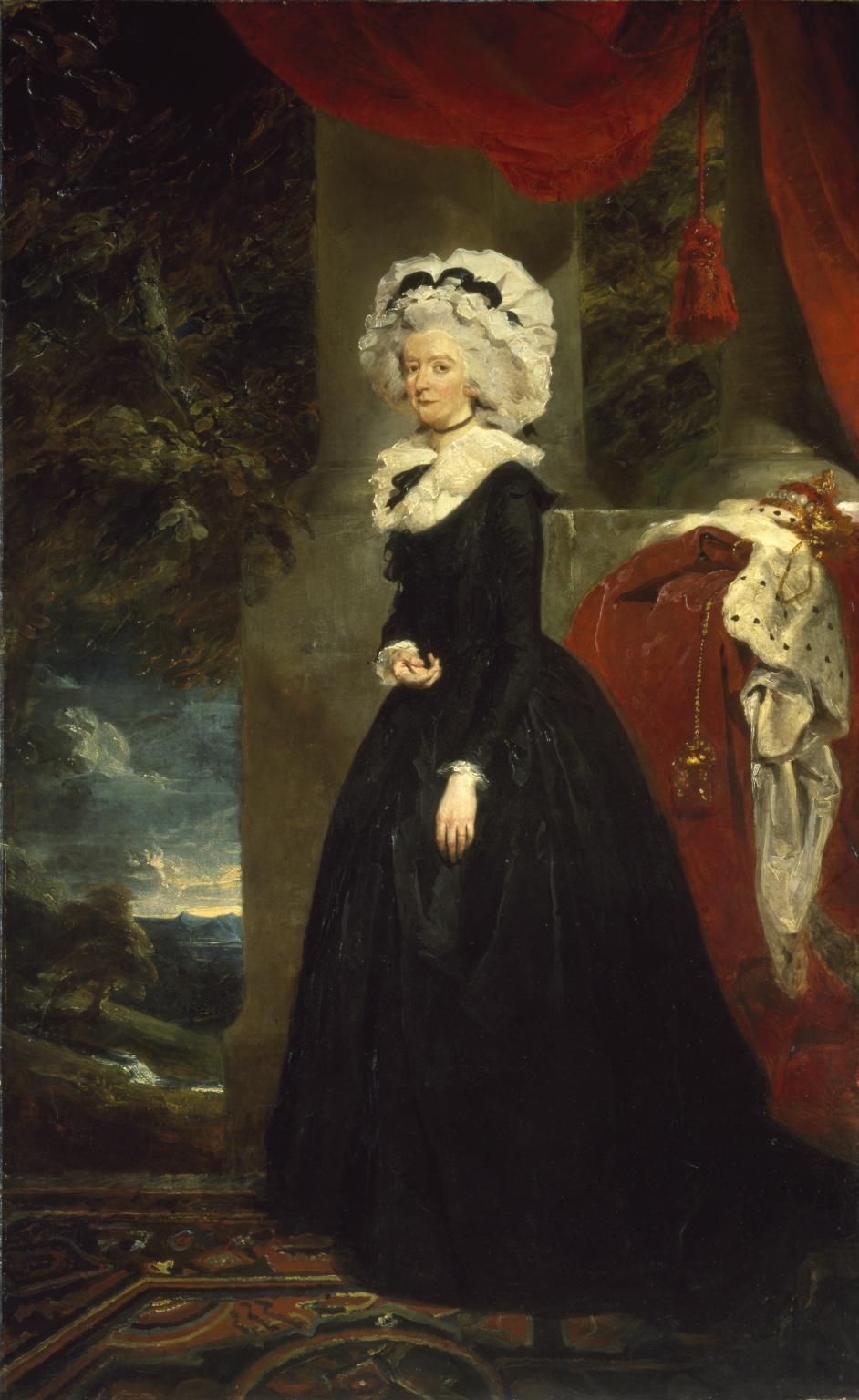
Sir Thomas Lawrence, Philadelphia Hannah, 1st Viscountess Cremorne exhibited 1789
Lady Cremorne is shown standing confidently, gazing directly out at the viewer. This seems apt given her high social standing: she was lady-in-waiting to Queen Charlotte and her grandfather was William Penn, who established the British colonial settlement in Pennsylvania, America. Thomas Lawrence was only 19 when he painted this imposing portrait, and it was his first full-length painting. He included it among his exhibits at the Royal Academy in 1789, where it caught the press’s attention. Lawrence was heralded as the successor to the aging Joshua Reynolds. Soon after this, Lawrence painted Queen Charlotte, a prestigious commission perhaps suggested by Lady Cremorne herself.
Gallery label, February 2024
24/30
artworks in The Exhibition Age
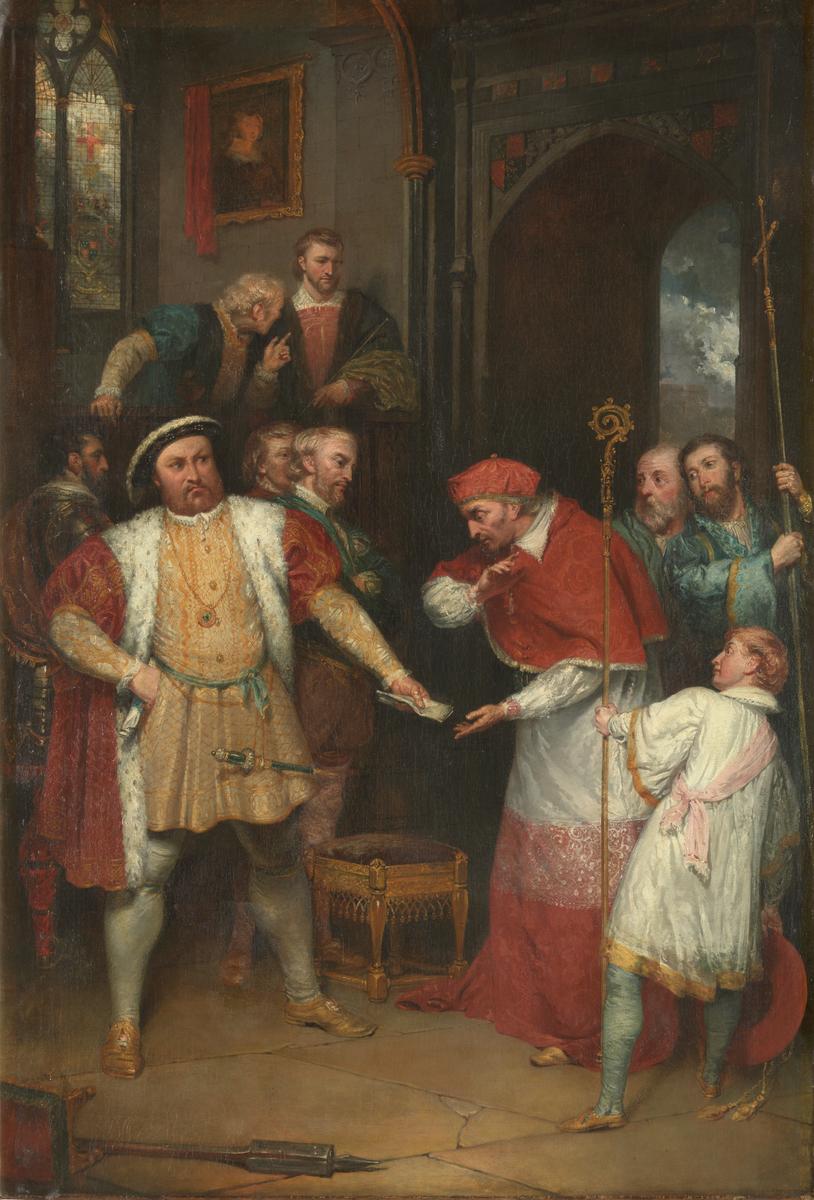
Henry Monro, The Disgrace of Wolsey exhibited 1814
Henry VIII stands commandingly on the left, handing papers to Cardinal Thomas Wolsey. This signals Wolsey’s downfall – as the King’s chief adviser he failed to secure the annulment of Henry VIII’s first marriage, ultimately leading to his arrest for treason. While a historical subject, Henry Monro drew his inspiration from Shakespeare’s play Henry VIII. He worked on the painting over 5 months in late 1813, employing ‘Ben’ from the local workhouse to model as Wolsey. Monro had been an ambitious young artist, and when the painting was exhibited at the British Institution in 1814 after his early death in March that year, it secured Monro’s celebrity.
Gallery label, February 2024
25/30
artworks in The Exhibition Age
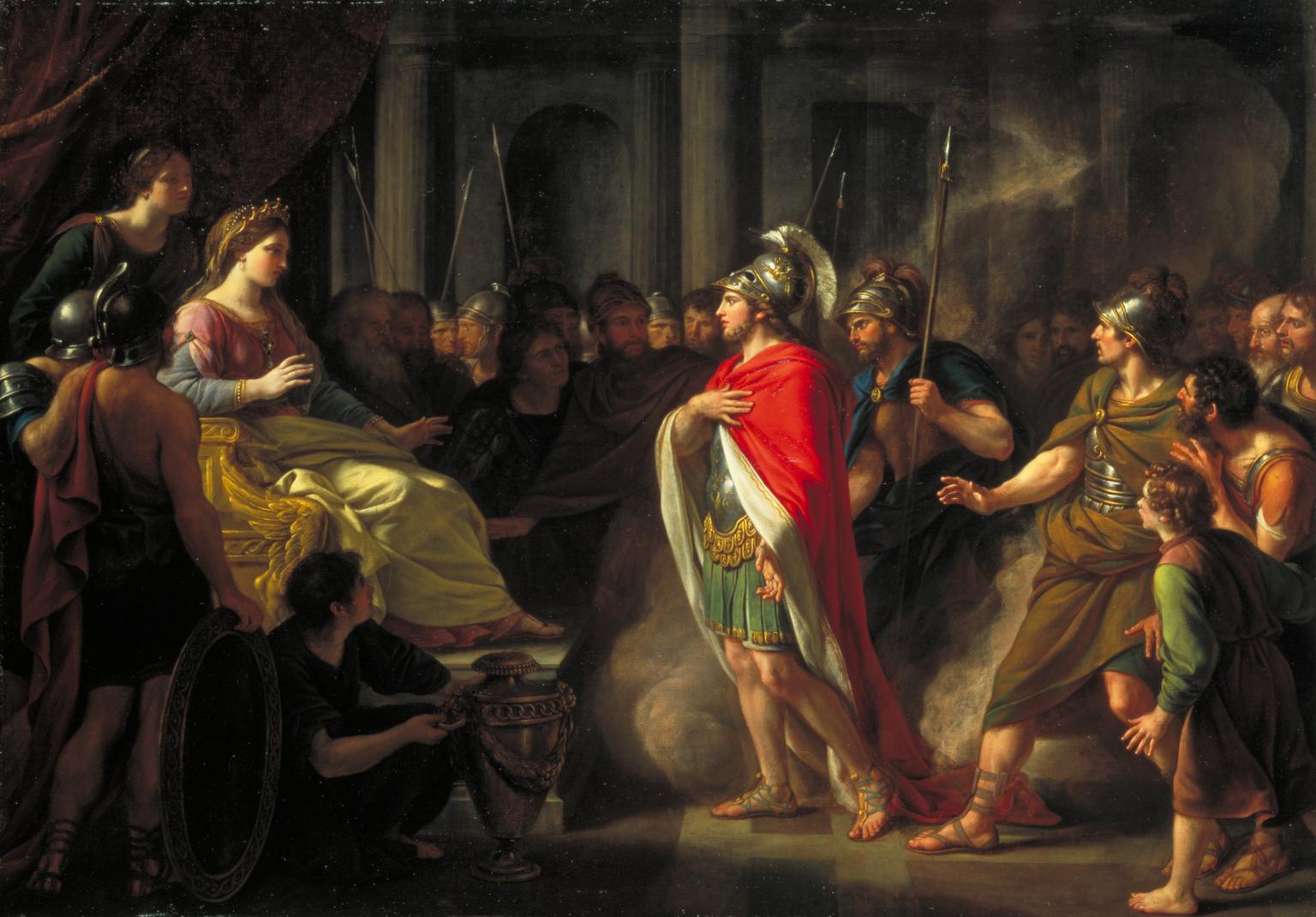
Sir Nathaniel Dance-Holland, The Meeting of Dido and Aeneas exhibited 1766
This picture shows the meeting of the Trojan prince Aeneas and the Carthaginian queen Dido, from Virgil’s epic poem, the Aeneid. Aeneas was shipwrecked near Carthage after the sack of Troy. The goddess Venus made Dido fall in love with him and helped him to hide in her citadel. He watches Dido welcome his fellow Trojans and when she asks to see their ‘king’ the mist clears and Aeneas reveals his identity. Dance-Holland made this picture while he was in Rome and sent it to London to be exhibited as a way to advertise his imminent return to Britain.
Gallery label, February 2016
26/30
artworks in The Exhibition Age
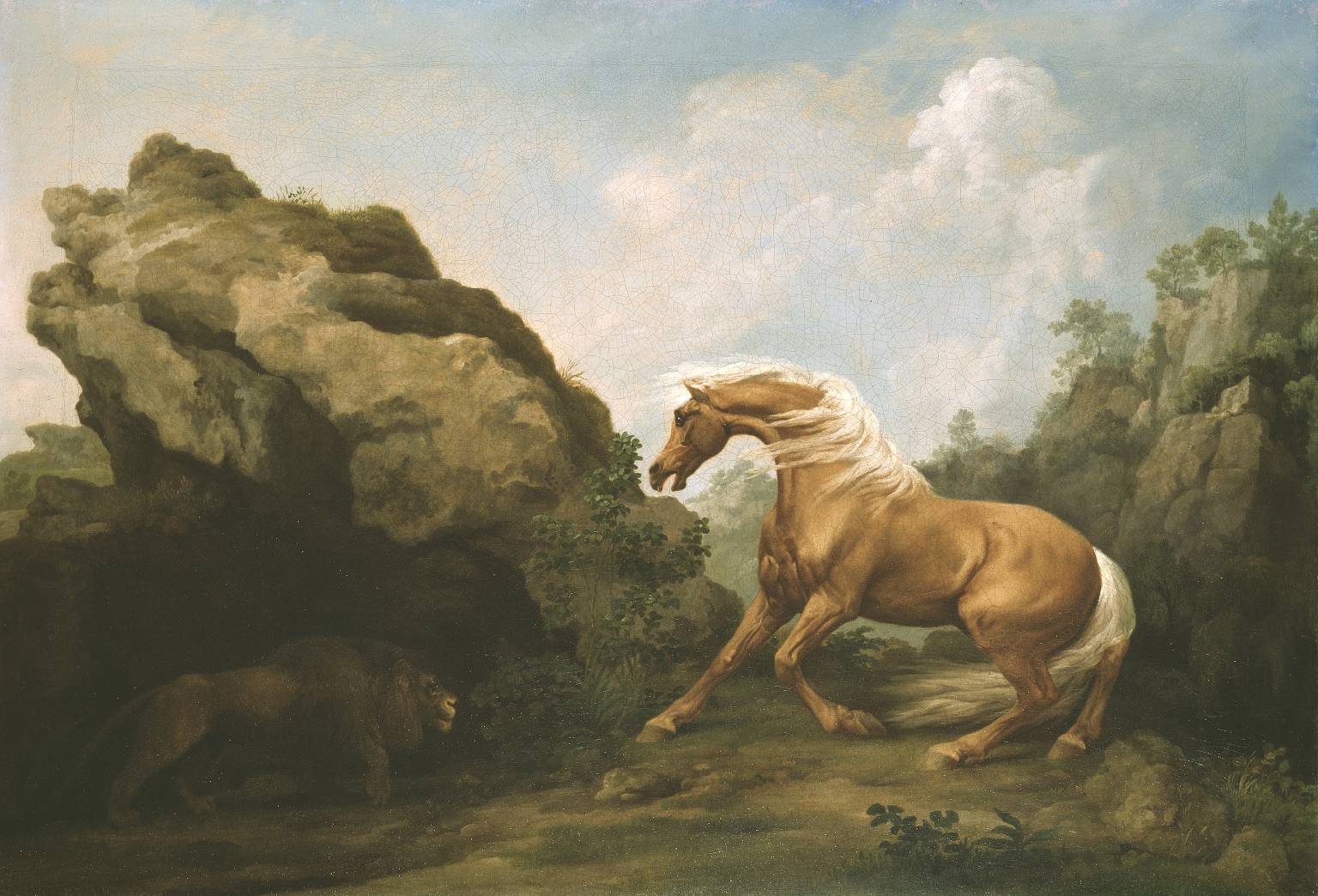
George Stubbs, Horse Frightened by a Lion ?exhibited 1763
The dramatic theme of a lion attacking a horse preoccupied Stubbs for over thirty years. This painting comes from a series of four episodes in a terrifying attack on a passive horse. This is the first stage, as the horse scents the lion emerging from its cave and rises up in fright. The setting for this violent encounter is the harsh, rocky landscape of Creswell Crags in the Peak District. The area was then an inaccessible, wild region that fascinated Stubbs. The scenery makes a suitably romantic background for the ‘sublime’ drama of the scene.
Gallery label, February 2016
27/30
artworks in The Exhibition Age
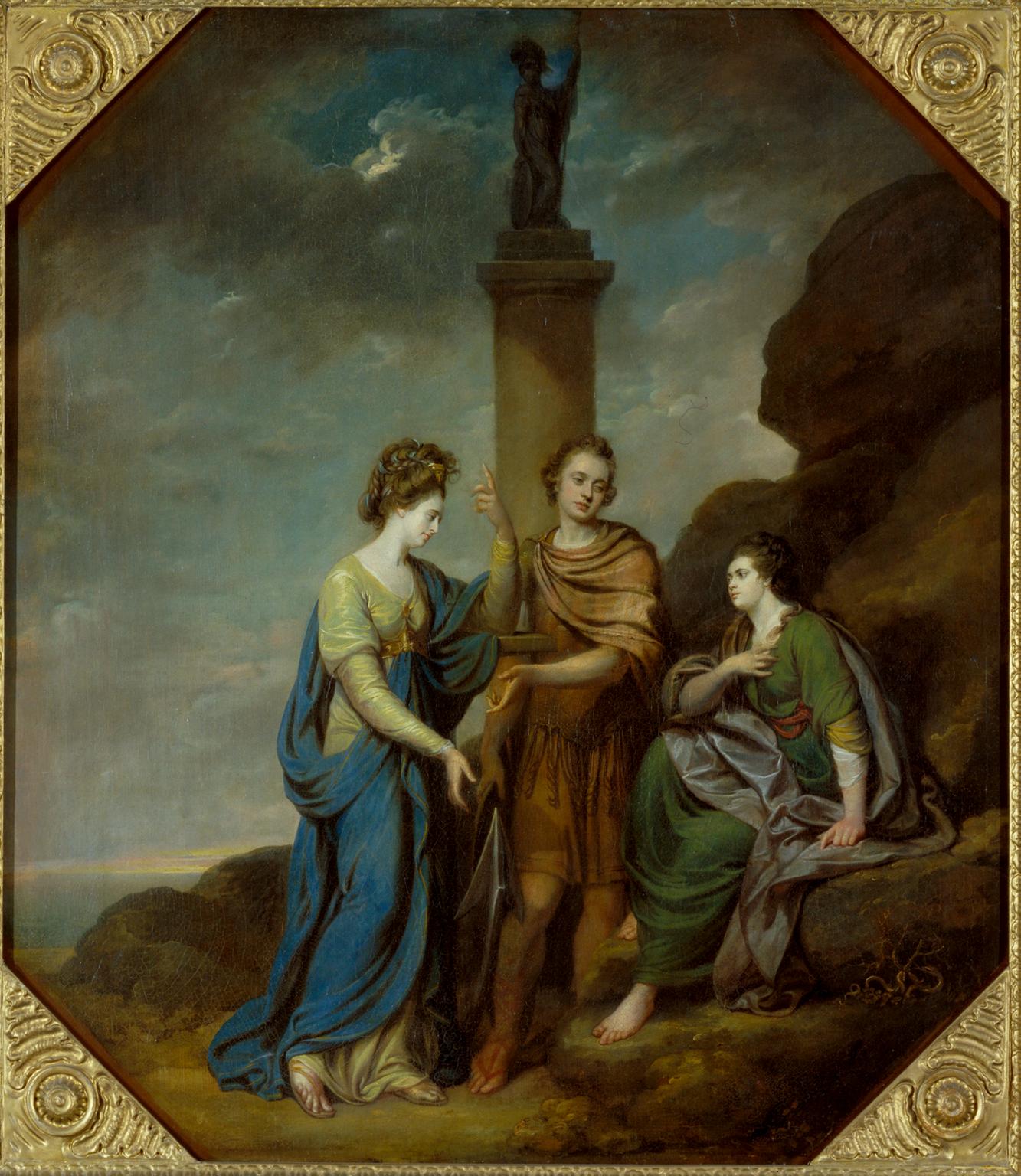
Richard Cosway, Portrait of a Gentleman, his Wife and Sister, in the Character of Fortitude introducing Hope as the Companion to Distress (‘The Witts Family Group’) 1770
Although principally a portrait miniaturist (see cabinet 2: The Portrait Miniature in the Eighteenth and Nineteenth Centuries), Richard Cosway also produced some larger-scale works in oil. This allegorical portrait was painted following the death of a young London linen draper, Broome Witts, in 1769. Witts is shown here in the role of Fortitude, introducing his sister Sarah in the guise of Hope (left) to his wife Elizabeth, depicted as Distress. This memorial image was presumably commissioned by one or both of these ladies.
Gallery label, August 2004
28/30
artworks in The Exhibition Age
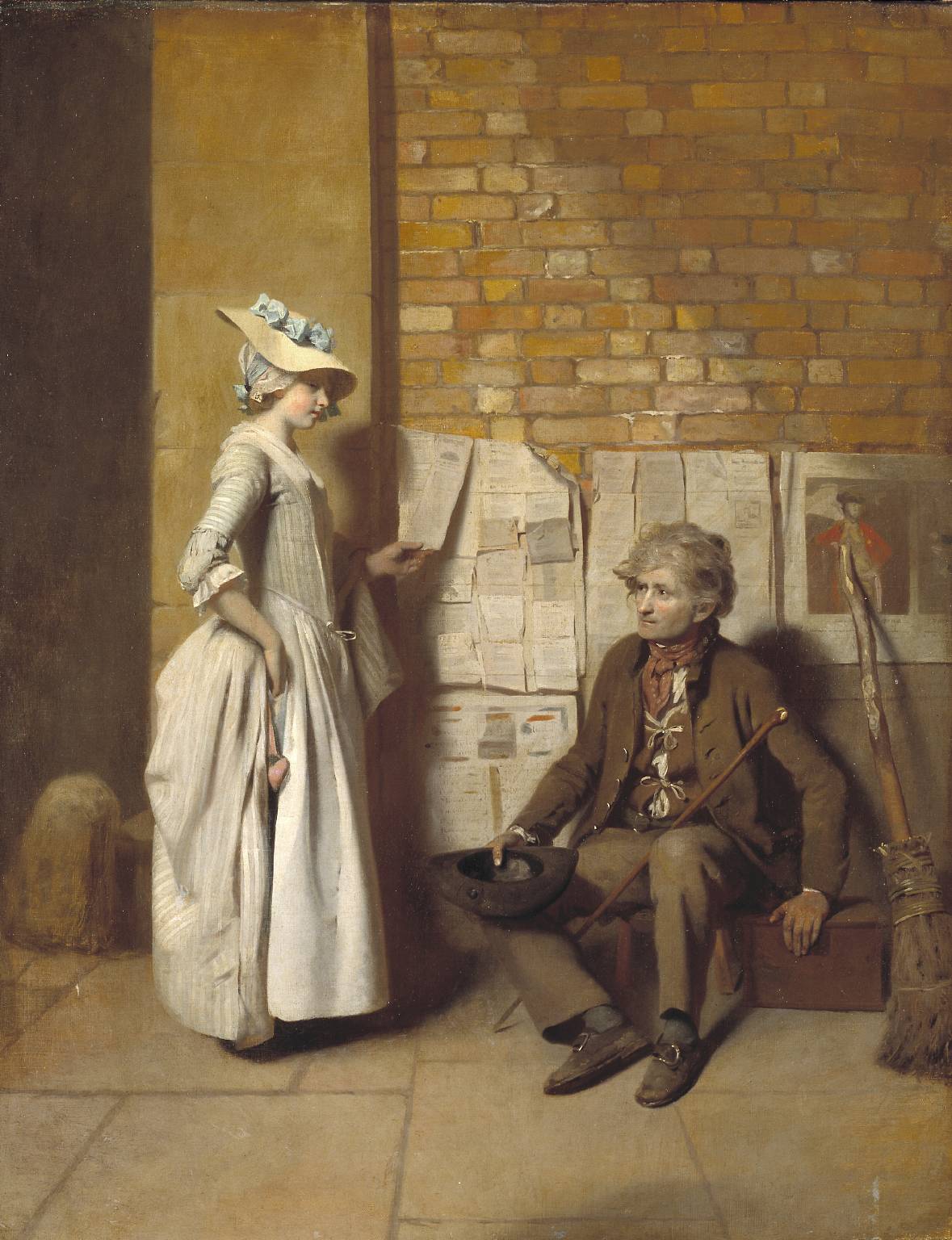
Henry Walton, A Girl Buying a Ballad exhibited 1778
This painting shows a fashionable young woman approaching an old ballad-seller on the street, whose printed wares are pinned up behind him. Henry Walton exhibited this painting at the Royal Academy in 1778. He likely hoped this imaginative image of city life would appeal to exhibition-goers. But he may also have intended a political reading too. The two portrait prints on the right are recognisable as General William Howe and his brother, Admiral Richard Howe. Their doubts about Britain’s war with Revolutionary America had recently led them to resign from military command. This was highly topical as the war was hugely controversial in Britain.
Gallery label, February 2024
29/30
artworks in The Exhibition Age
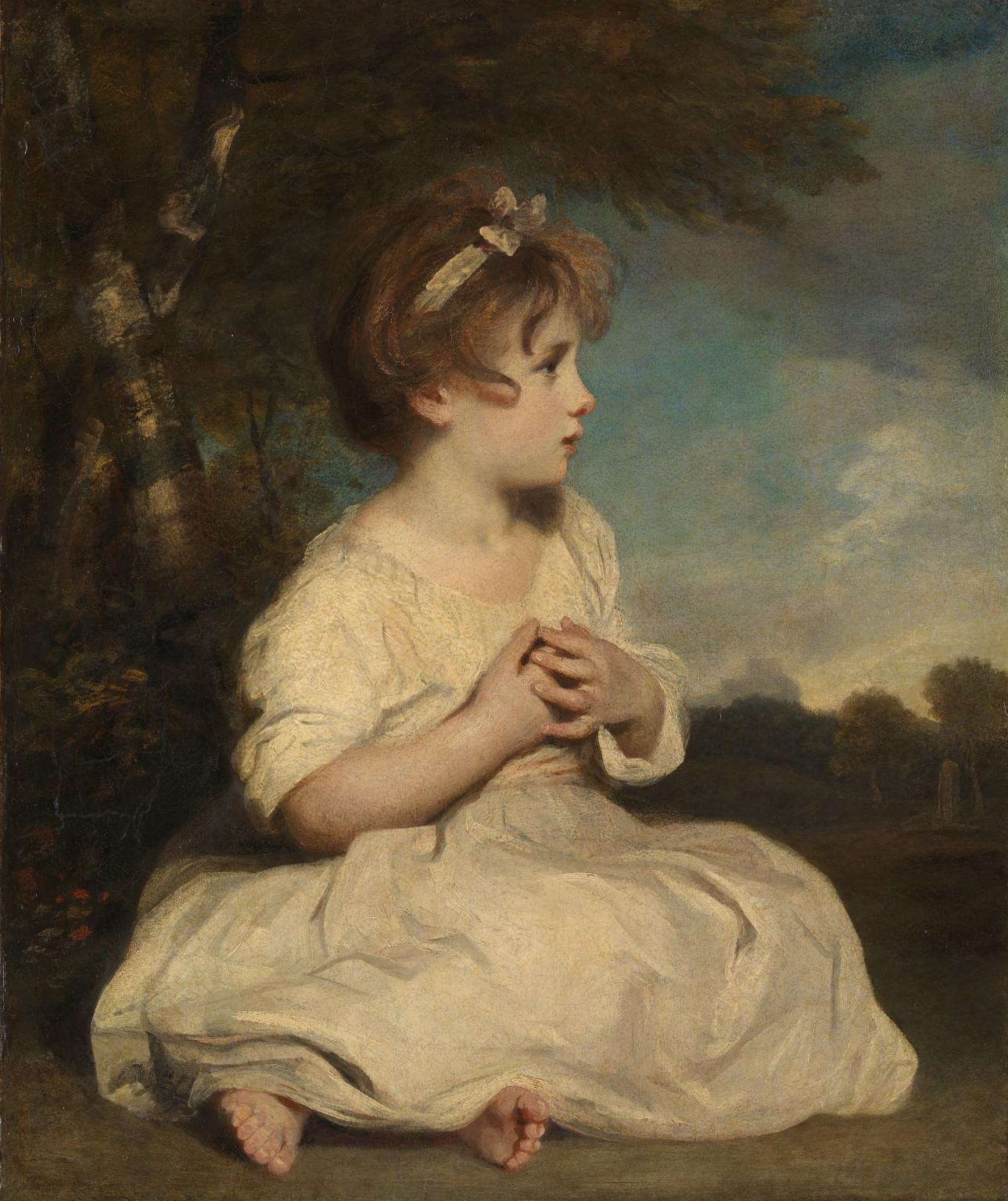
Sir Joshua Reynolds, The Age of Innocence ?1788
The identity of Joshua Reynolds’s young model is uncertain. It is perhaps Reynold’s great-niece Theophila Gwatkin, a Miss Anne Fletcher, or a Lady Anne Spencer (the youngest daughter of the 4th Duke of Marlborough). This painting is an example of a ‘fancy’ picture, a type of 18th century painting showing figures, particularly children, playing out various roles. It was painted over one of Reynolds’s existing paintings, titled A Strawberry Girl. He altered all elements of the girl’s figure except for her hands. The Age of Innocence was one of Reynolds’s most popular images – more than 323 full-scale copies were made of it between 1856 and 1893.
Gallery label, October 2023
30/30
artworks in The Exhibition Age
Art in this room






























You've viewed 6/30 artworks
You've viewed 30/30 artworks
